Mixed media artist Kelly Kozma, grew up in Bucks County, Pennsylvania and received her BFA from Moore College of Art & Design.
Kelly has participated in several solo and group shows in Philadelphia, New York, Delaware, and Miami, Florida for Art Basel.
Her current work combines drawing, painting and hand embroidery with elements of chance and probablity to create vivid, pattern driven pieces.
In this interview, Kelly walks us along the path of her artistic journey so far and we discover how reconstruction is a key theme of her work. We learn about the techniques and tools that assist her along the way and how her little boy provides constant inspiration.
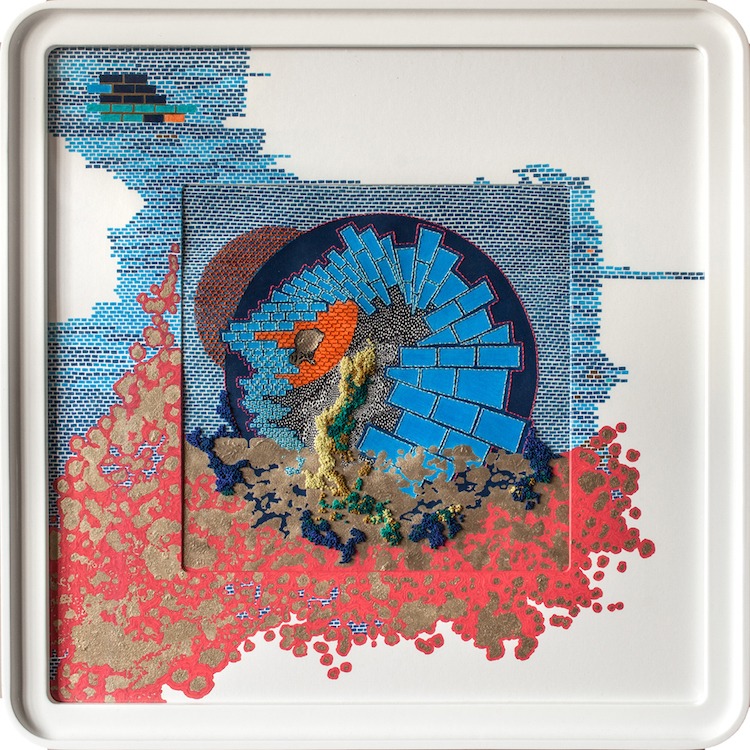
Sewing myself into the work
TextileArtist.org: What initially attracted you to textiles as a medium?
Kelly Kozma: It actually took a while for me to come around to textiles. When I was younger I only associated textiles with quilts and clothing, more functional items. I had a lot of stigmas about what art was, and it took a lot of time, exploration, and life experience to break down those perimeters.
I started undergrad as a 2D Fine Arts major, and then dabbled in graphic design and textiles. I struggled with labels and thought I could only be one type of artist.
Initially I was convinced I would become a figure painter, as many of us do, being immersed in countless hours of drawing nude models in art school. It wasn’t until I started painting life-size portraits on fabric that I started to get the textile itch.
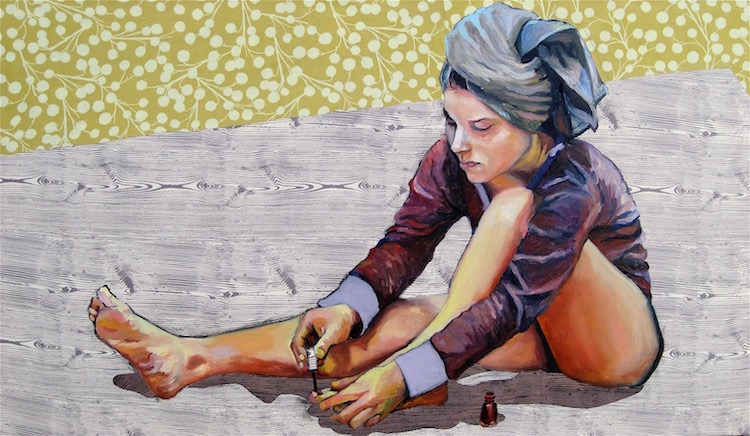
I found myself more interested in the patterned backgrounds than the figures themselves and so began my shift into abstract work, which eventually led me to fiber art.
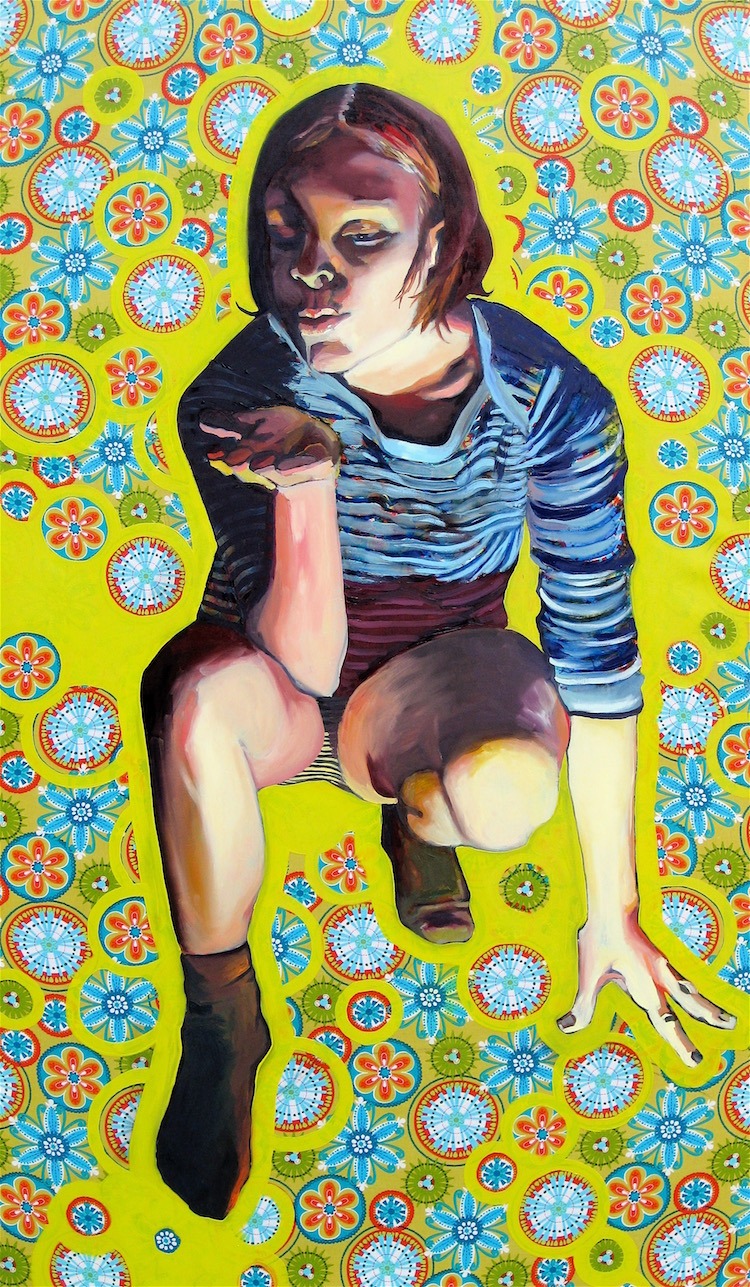
And, more specifically, how was your imagination captured by stitch?
Aside from some counted cross-stitch projects in childhood, I first experimented with stitch in a bookbinding class in 2008. In that case, the stitches were serving the purely functional purpose of holding the pages together.
I took the techniques I learned and started fooling around with them on drawings. I loved the dimension and shadows the stitches created on the paper. I loved the idea of mark making with thread. And I loved the feeling it gave me. It was as if with each stitch I made, I was sewing a piece of myself into the work.
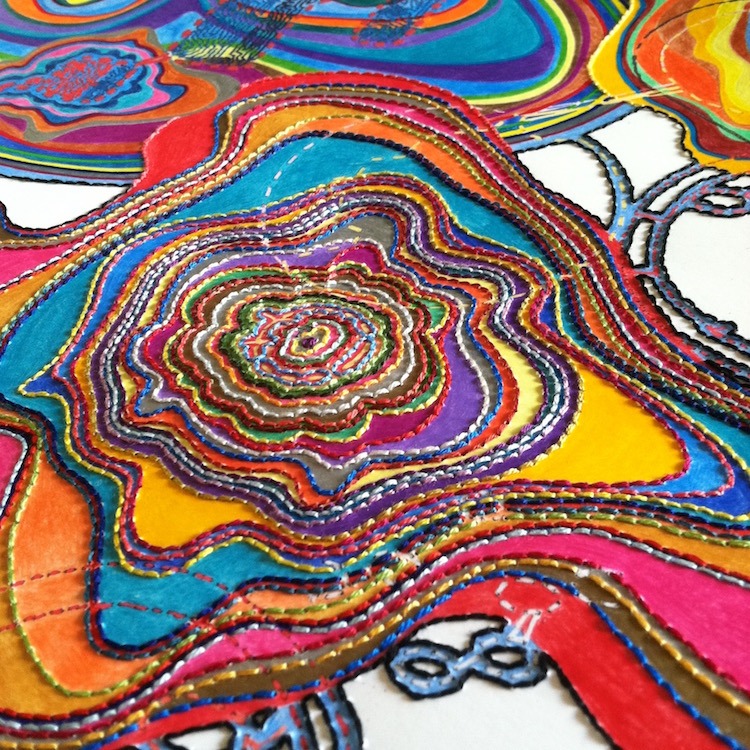
It was the most emotionally fulfilled I had felt as an artist and it became something I needed to do: a zen, meditative practice of self-care.
I found myself drawn to stitching on paper because it felt like I was taking something fragile and strengthening it, which also reflected things that were going on in my own life outside of my work.
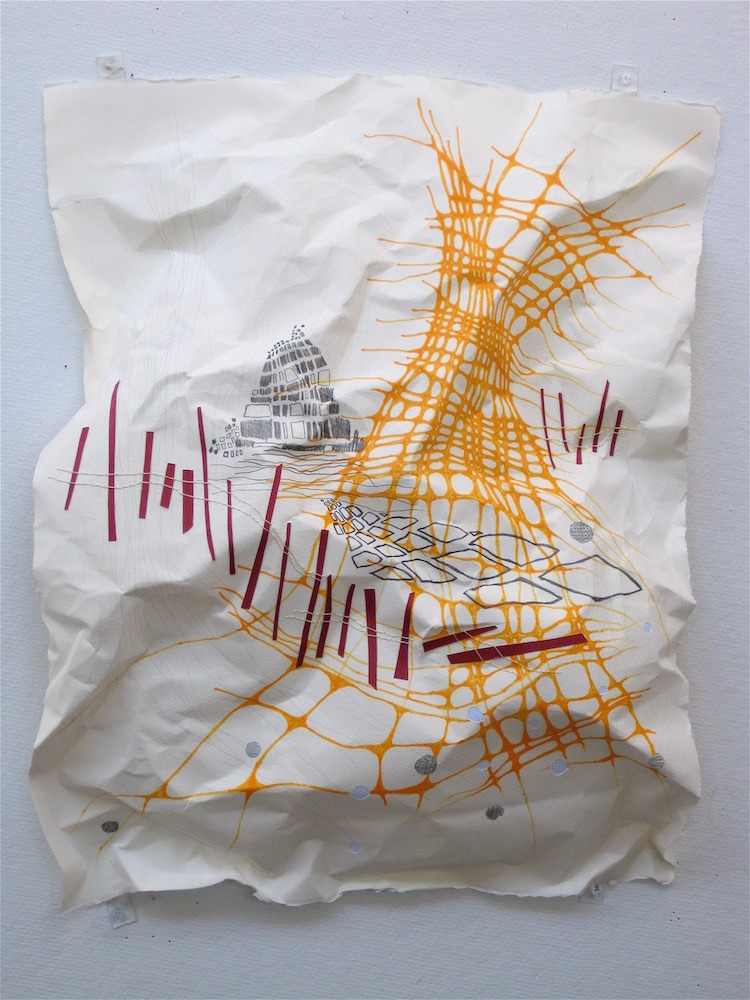
What or who were your early influences and how has your life influenced your work?
Whenever I’m asked this question I always get nervous, like I should have a memorized list of ten artists, a good mix of historical references as well as contemporary artists, and be able to spout out a bunch of facts about all of them. In all honesty, I don’t.
The biggest influences that led me to this career were some really great teachers who nurtured my creative side and gave me the confidence to believe in myself.
The city of Philadelphia was also a huge influence on my work. There is a vibe that is almost hard to describe if you haven’t spent a good deal of time there, but I’ll try. It’s gritty, a little dirty, bright, loud, chill, unapologetic, inspiring, surprising, yummy, sweaty, and sparkly.
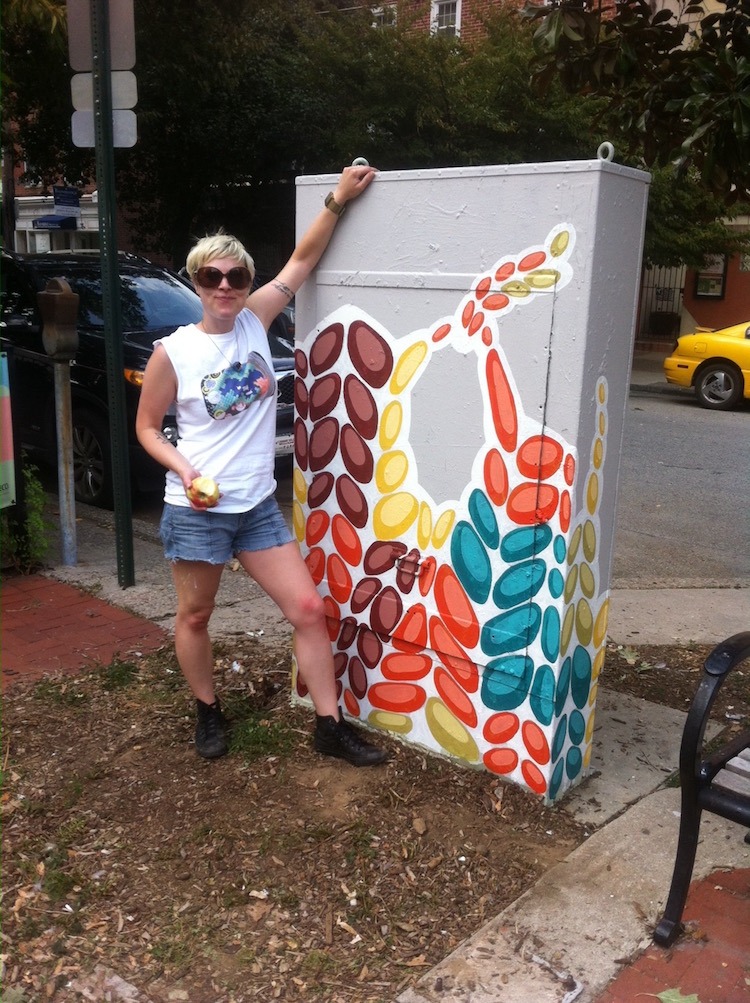
The artists are incredibly encouraging and supportive of one another. It’s not cutthroat competitive like a lot of other places.
We get excited to see people in our community grow and succeed; it makes the individual artist want to push him/herself further.
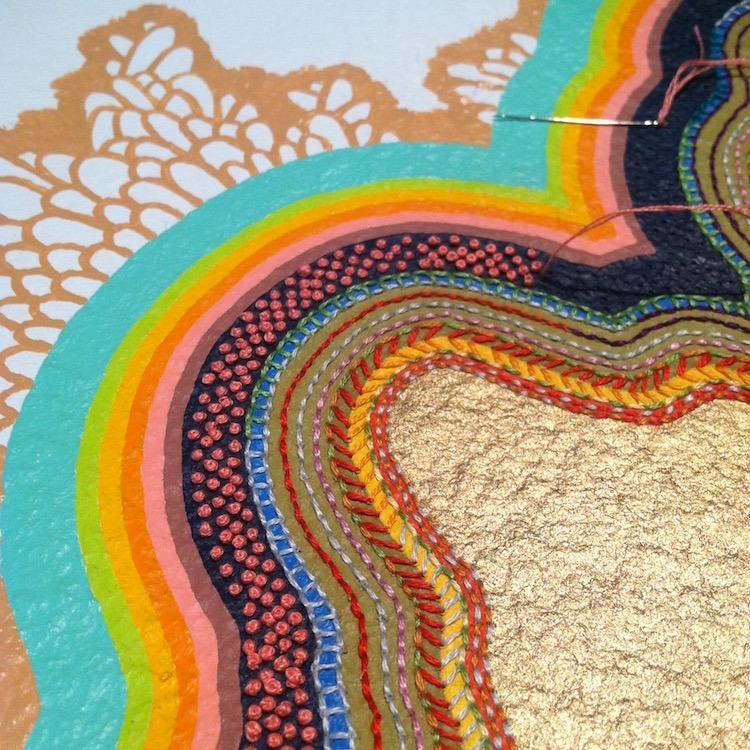
A desire to make art
What was your route to becoming an artist?
I kind of think that we are all born artists, and our crafts just take different shapes. That sounds kind of hokey, but I believe it. I don’t know that I could pick a point in time when I became an ‘artist’; I always just liked to make things and use my hands.
But to answer a little more directly, I went to Moore College of Art & Design right out of high school. I stayed for a year and a half and then left.
I stayed in the city, worked retail, made a bunch of friends and acted like a crazy 20 something year old for a while. But I never stopped creating. I drew a ton, made gifts for friends, knitted like it was nobody’s business. The drive to ‘make’ never left, and I believe that it was in that downtime that I grew the most as an artist.
After a few years respite, I returned to school as a much different person with a desire to make art that was stronger than ever. It took almost ten years to complete my undergrad but I’m pretty sure that’s how it was meant to happen.
Tell us a bit about your chosen techniques.
In the past 7 years or so my work has taken some major shifts. My first solo show was with Paradigm Gallery + Studio, who still represents me, and was compiled of abstract drawings that I stitched into. I would say coloured pencil was the star in that show and stitch was still more of an accent or addition to the work at that point.
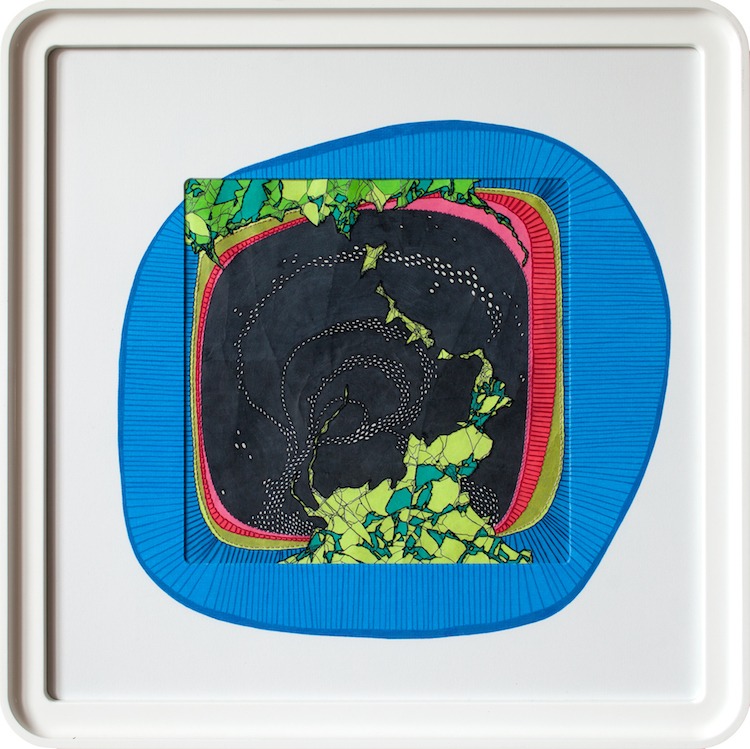
I also used a lot of methods of probability to choose my colours. That work was very much about finding a balance between my hand as an artist, and that, which is left up to chance.
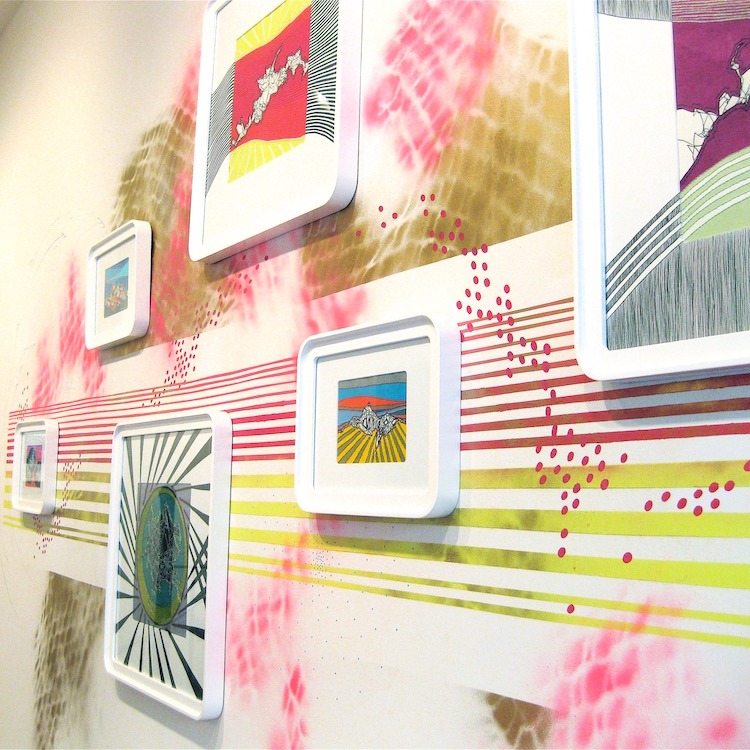
Fast forward a few years, embroidery began to take over as a medium and it was the coloured pencil and paint that were the accents.
I became obsessed with French knots and created the piece La Ultima, which was like a mini carpet on paper. I made a lot of work that depicted abstracted worlds that were reminiscent of Earth but seemingly existed elsewhere.
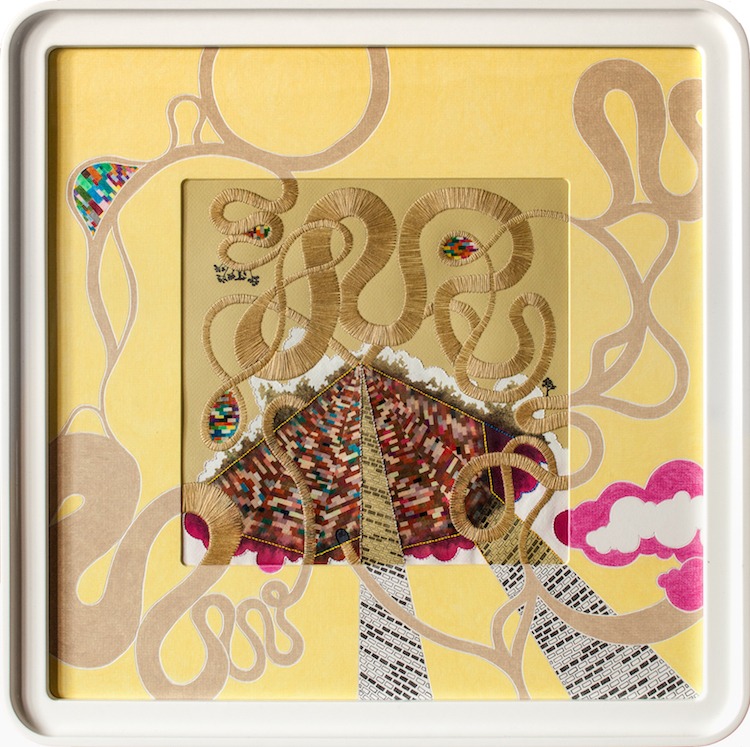
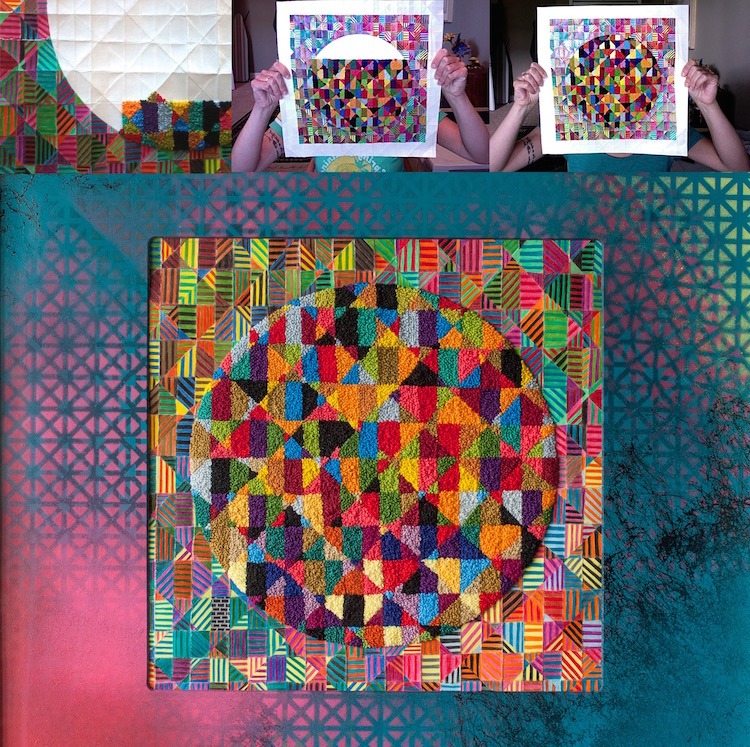
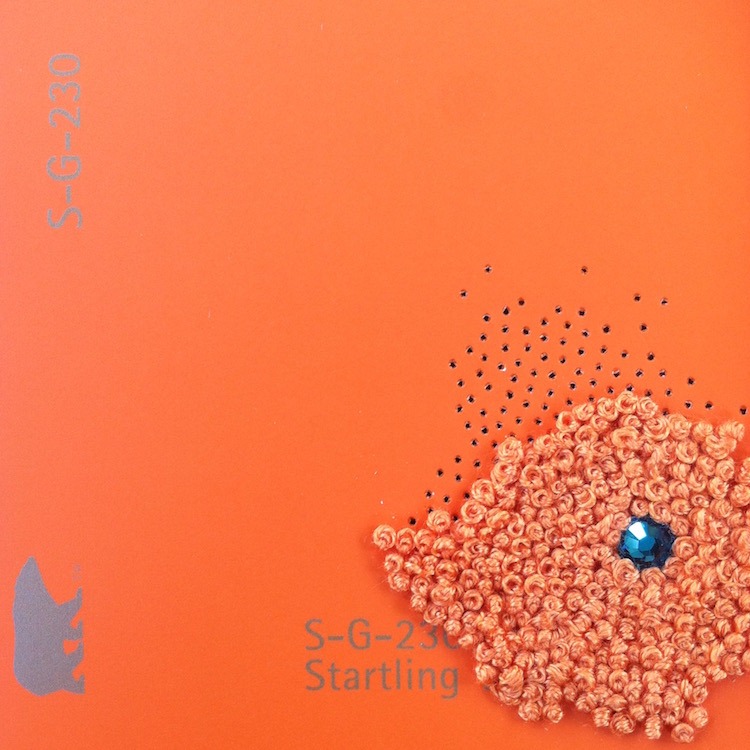
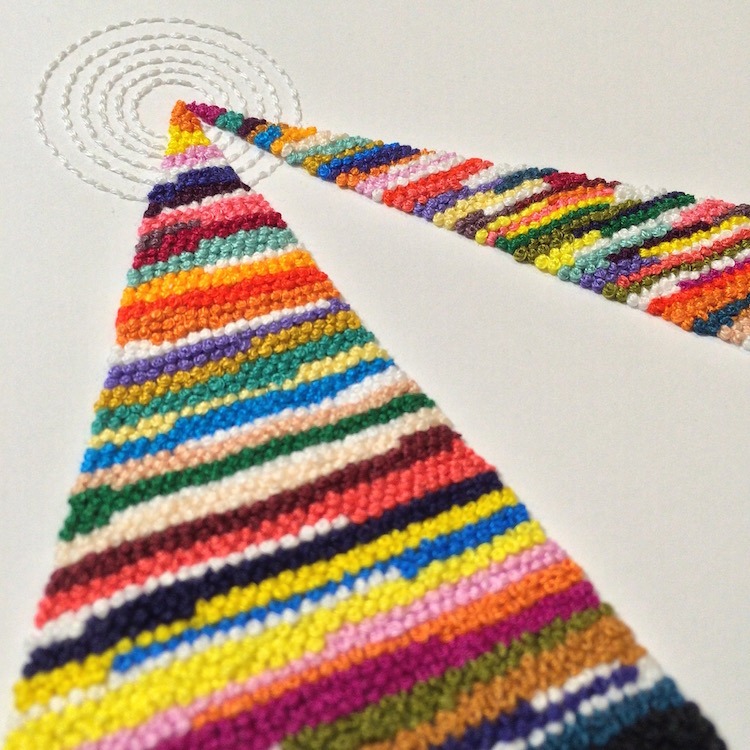
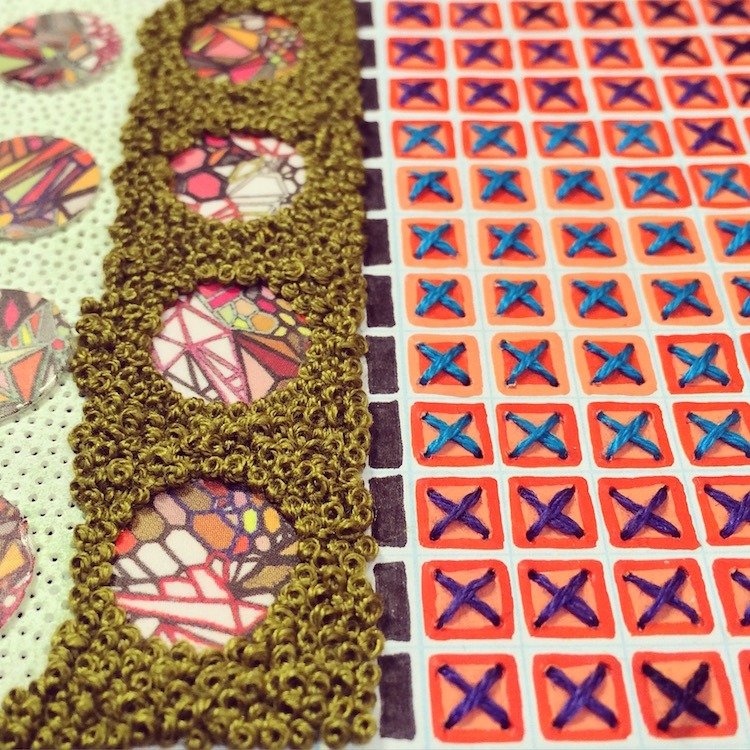
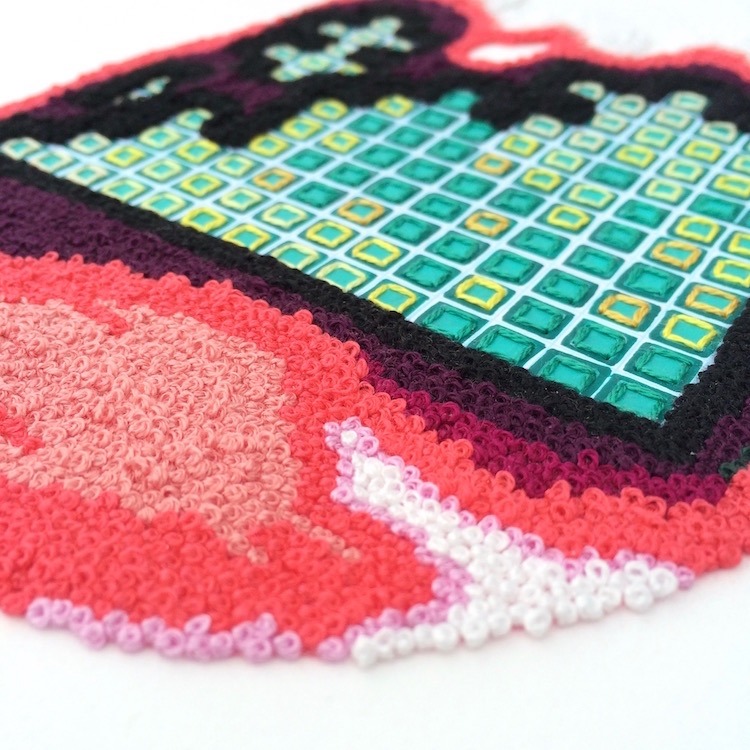
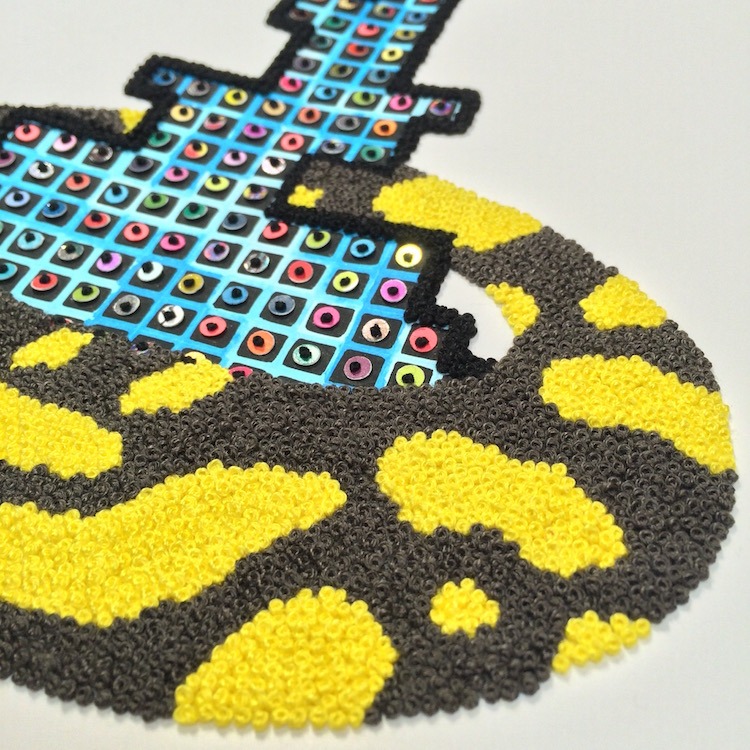
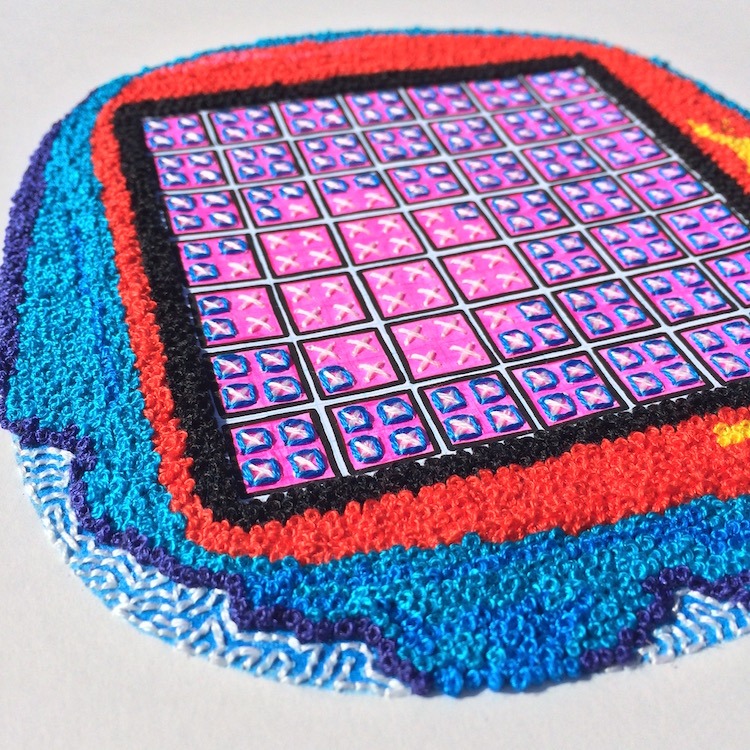
Then I started exploring the idea of deconstructing materials and putting them back together, which brings us to my current body of work.
I combined the functionality and aesthetic qualities of stitch, like I’d learned in that bookbinding class way back when, to create a series I refer to as my ‘punched paper pieces’.
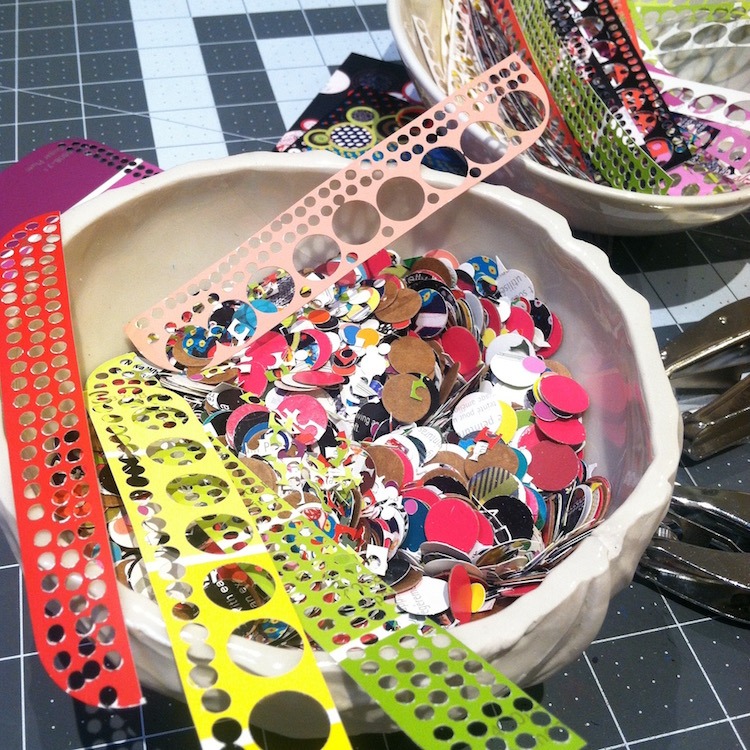
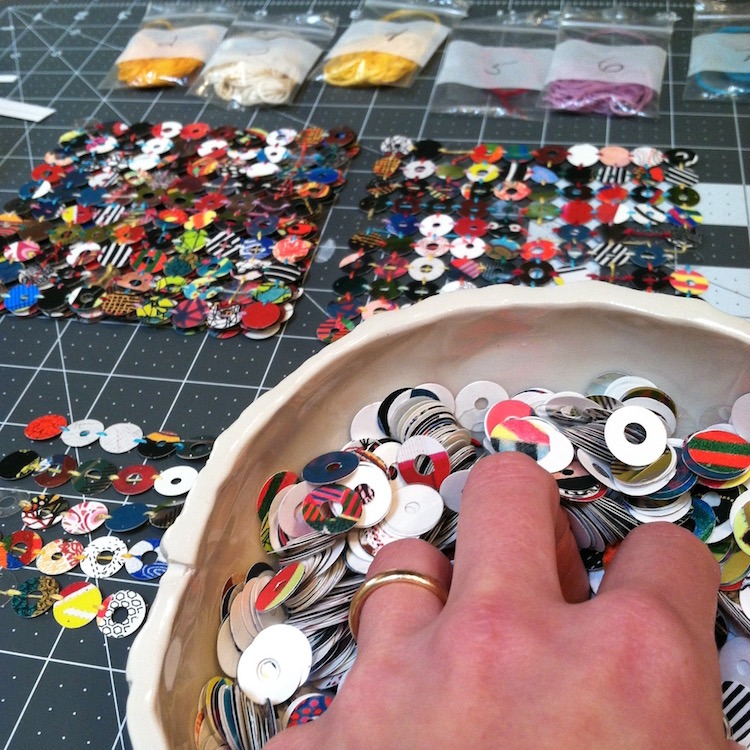
Using different sized hole punches, I break down various materials, most of which are repurposed. I choose materials that ignite something within me, whether it’s a sense of nostalgia, a bright palette or font or sometimes it’s just me wanting to give a cardboard box a second life in my art.
After collecting and punching the materials, I then stitch them back together, usually in a random order, drawing from my methods of leaving things up to chance.
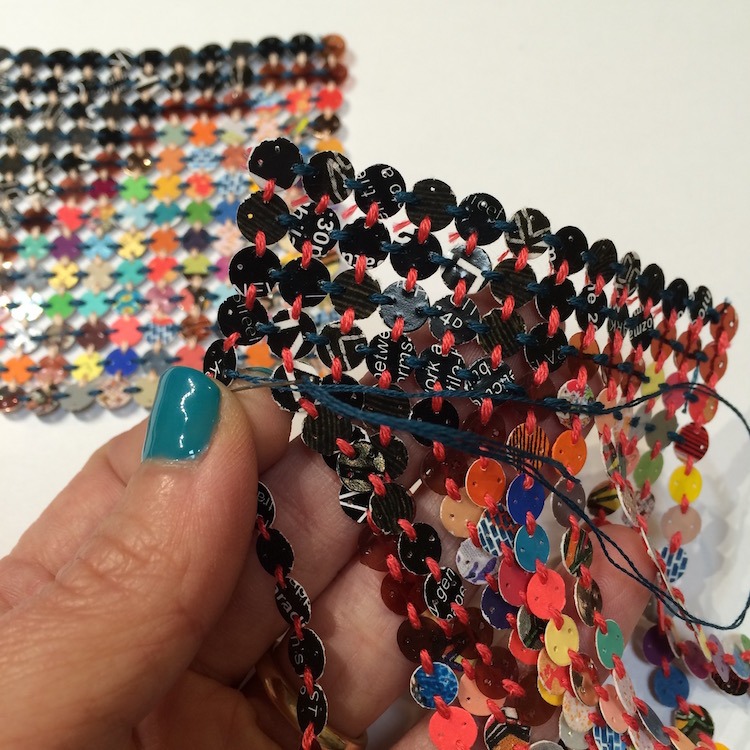
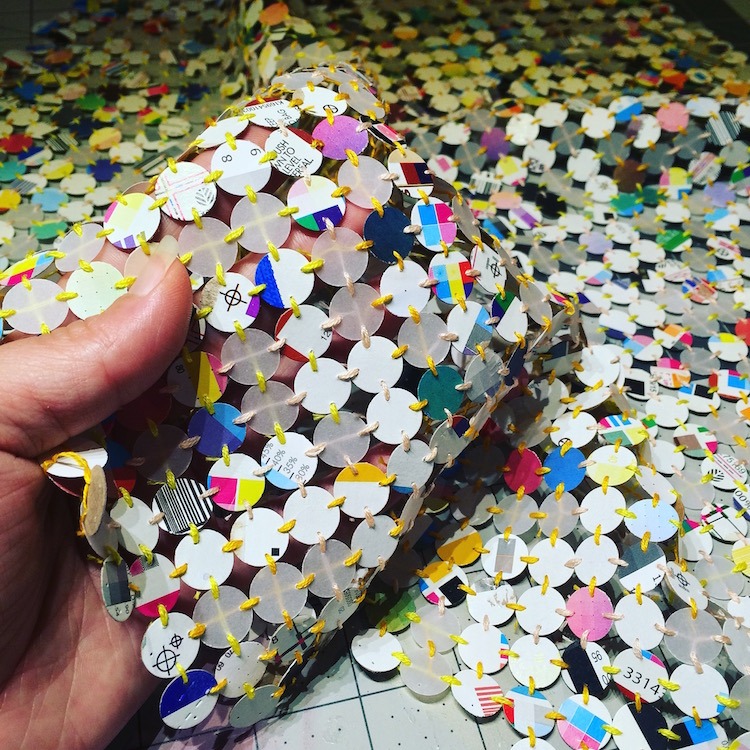
The act of deconstructing and reassembling is representational of human nature and how we are fragile beings that need rebuilding and strengthening throughout life.
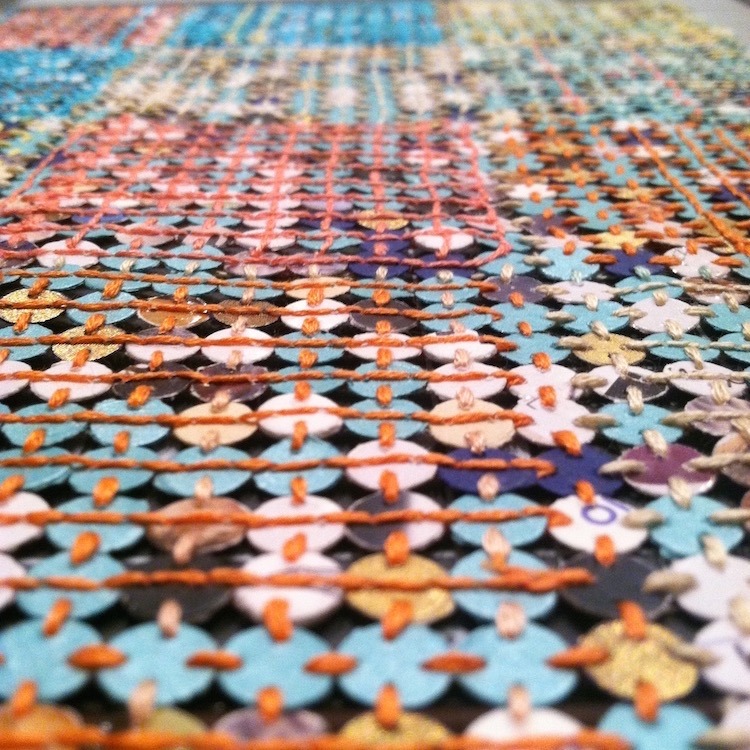
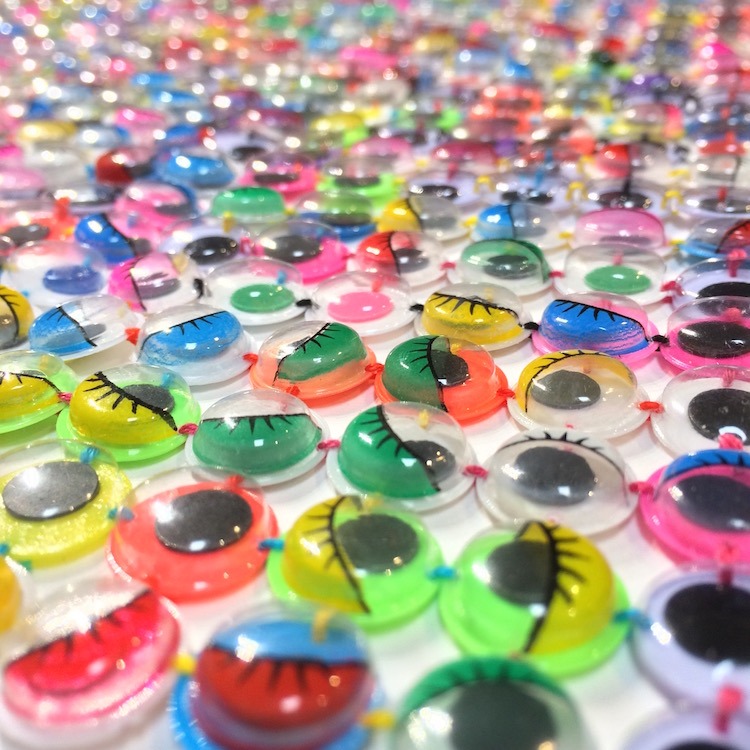
Storytelling is timeless
How would you describe your work and where do you think it fits within the sphere of contemporary art?
I think ‘meditative time capsules’ would be fitting. I consider each piece as a cross section from life.
In my current body of punched paper pieces, the work is sandwiched between two pieces of plexiglass, preserving memories, experiences, and ephemera, which may otherwise be forgotten.
Each individual circle brings its own story, but then they read differently as a whole from far away.
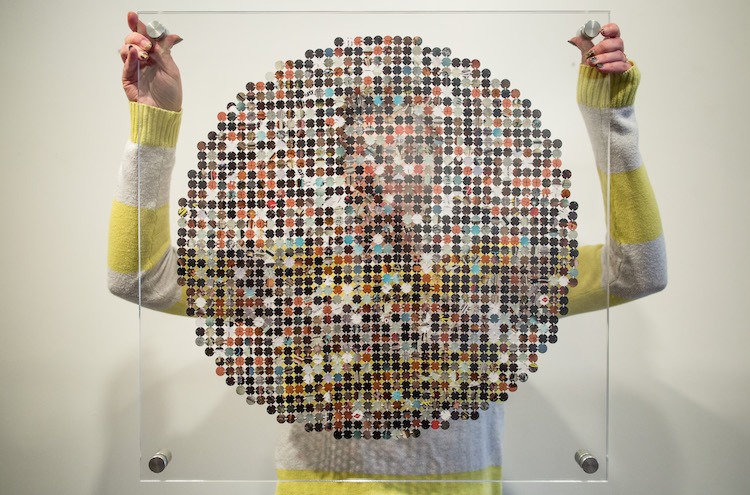
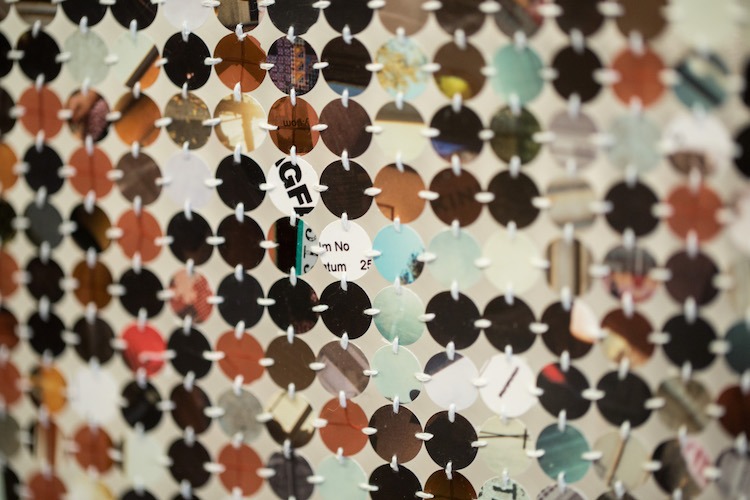
Community is definitely a strong theme in my work as well, and I see the stitches as the thing that brings and binds us all together.
I don’t really know where I fit into the contemporary art scene. Sometimes I wonder if I should be making things that are more on trend or would appeal to the masses. I still struggle with posts that don’t get many likes, and question how I could be cooler/better, essentially more popular–HA!
But then I check in with myself and I know that this work is meaningful to me and that I’m telling stories. Storytelling is timeless, like textiles in general.
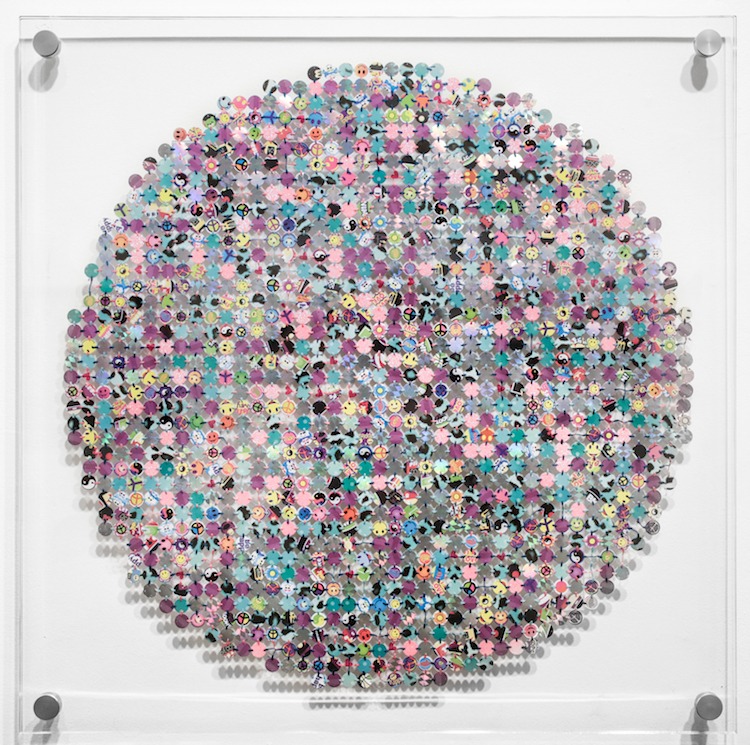
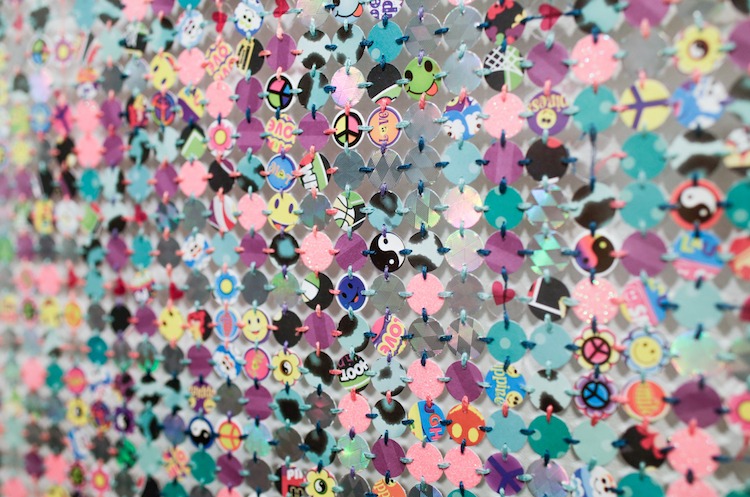
Do you use a sketchbook? If not, what preparatory work do you do?
I used to keep a sketchbook, but as the work has changed, so has my prep work.
I usually map things out on graph paper, and then there are always a bunch of scribbles and notes on scrap paper or napkins, scattered around the studio.
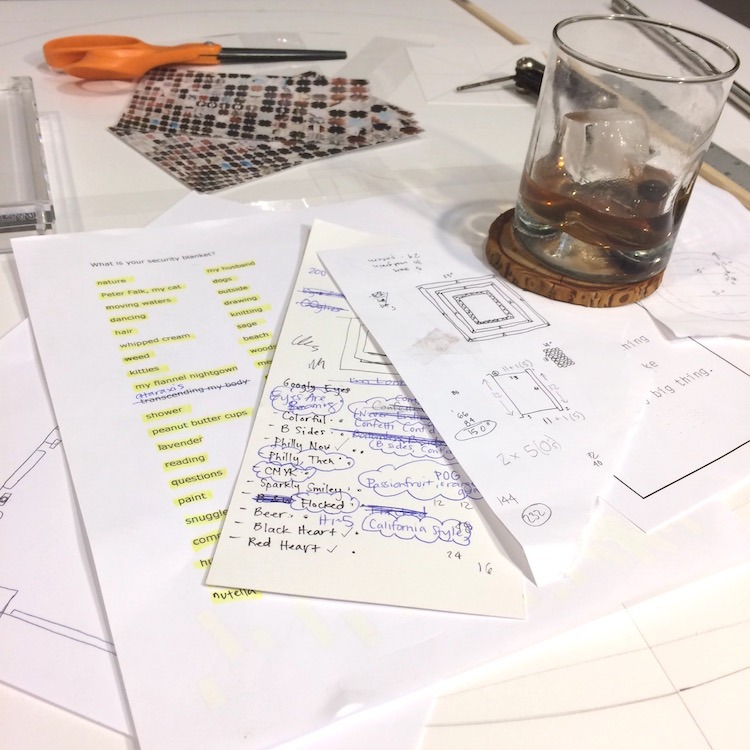
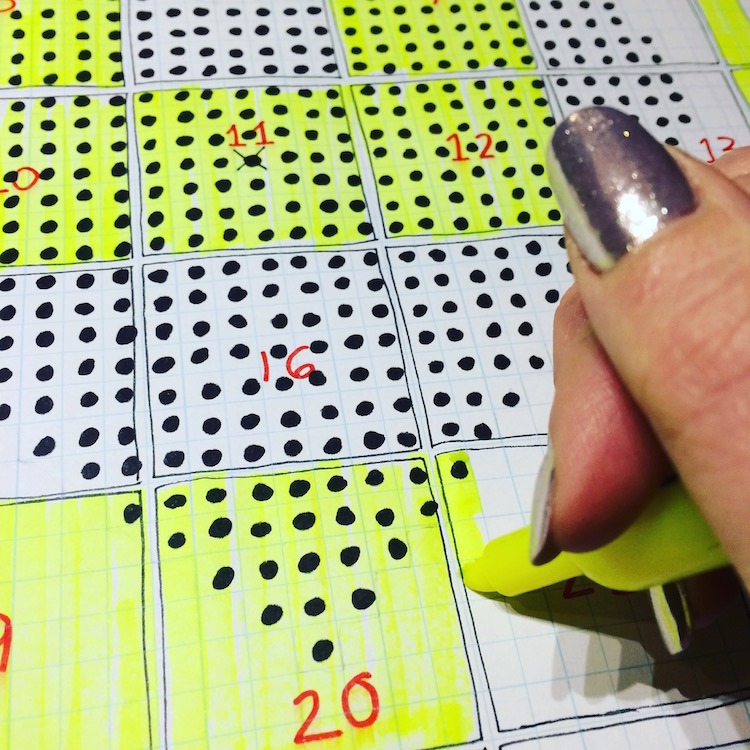
When each piece is completed, I gather up those scraps and store them in a binder for reference and to preserve the memories of the process. So I guess it’s a non-traditional sketchbook.
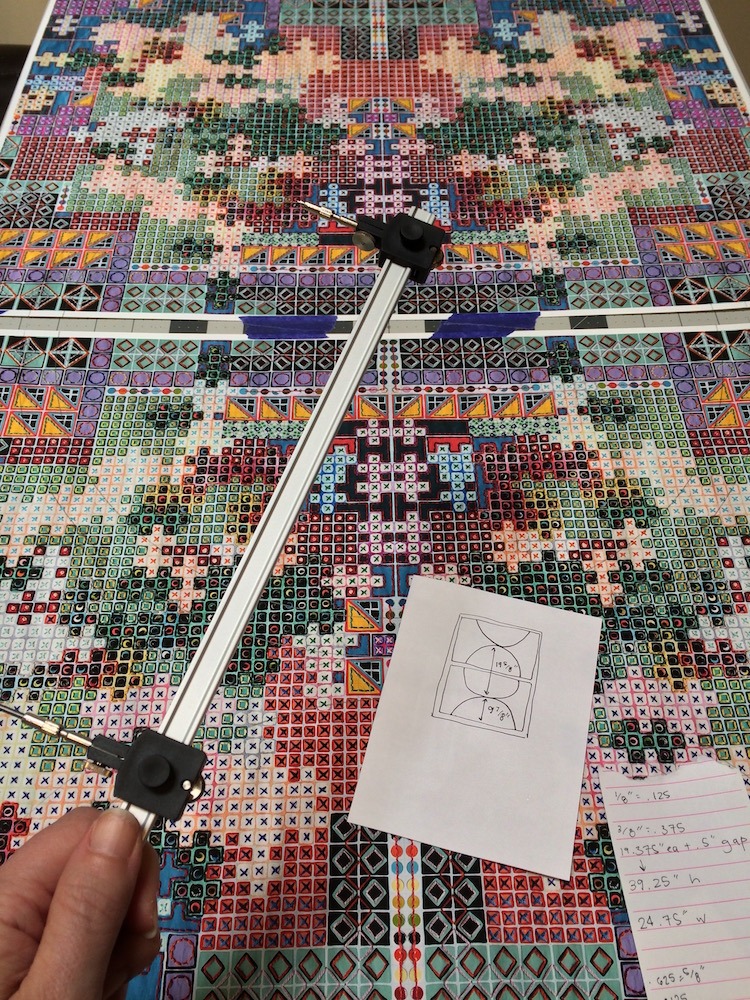
What environment do you like to work in?
Environment has become less and less important as the years go by.
I used to have a studio outside of my home, which was nice because I was able to get into a focused headspace and not be distracted by dishes, laundry, or other home life obligations. It was my time and it was all about the work.
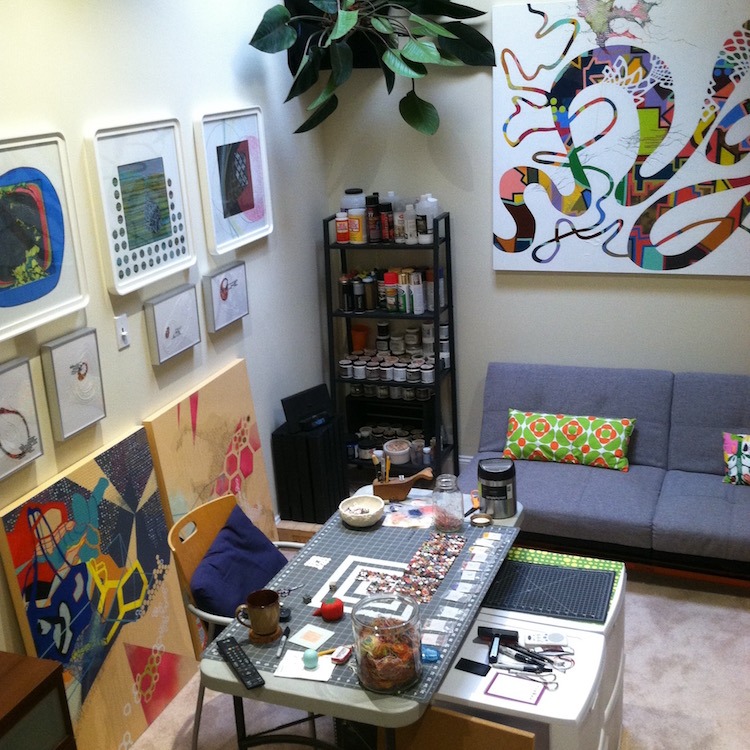
After a couple years, I moved my studio back home to save money, which was difficult at first, but I was quickly able to establish a disciplined practice and almost liked it more because I could work anytime.
Then almost two years ago, I had my son and it was less about where I was working and more about squeezing in the time.
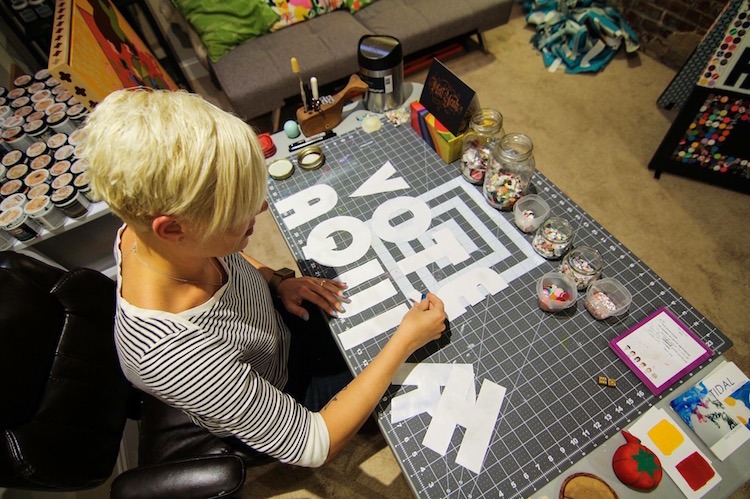
The past six months we’ve been moving around a lot while in the process of buying a new house. I’m down to whatever desk, table, or hard surface I can use.
I keep my materials very organised, most of it fits in a shoebox, so I can pick up and move quite easily.
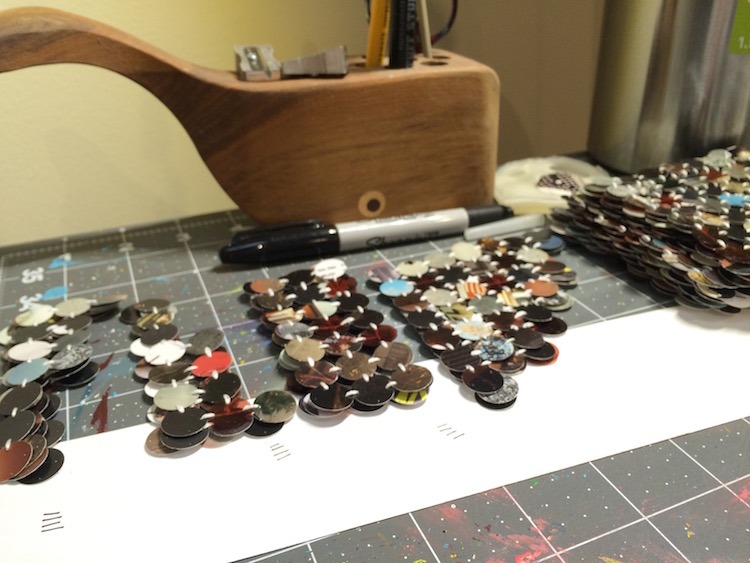
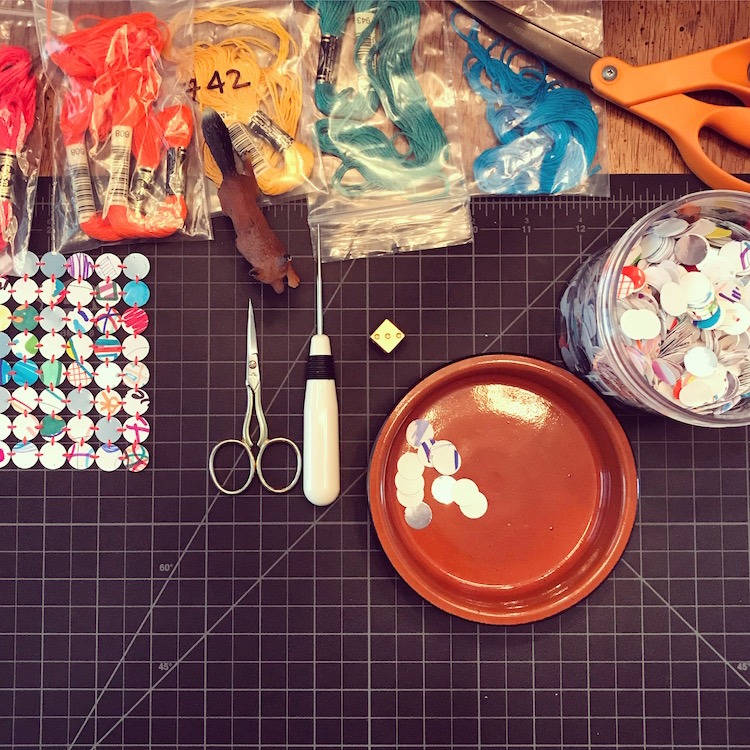
I will be excited to have my own space again, we are turning our detached garage into a studio at our new house, but I’ve also been fine with this nomadic studio practice.
Lately, it’s more about carving out the time to work, so I’m psyched to do it wherever I am.
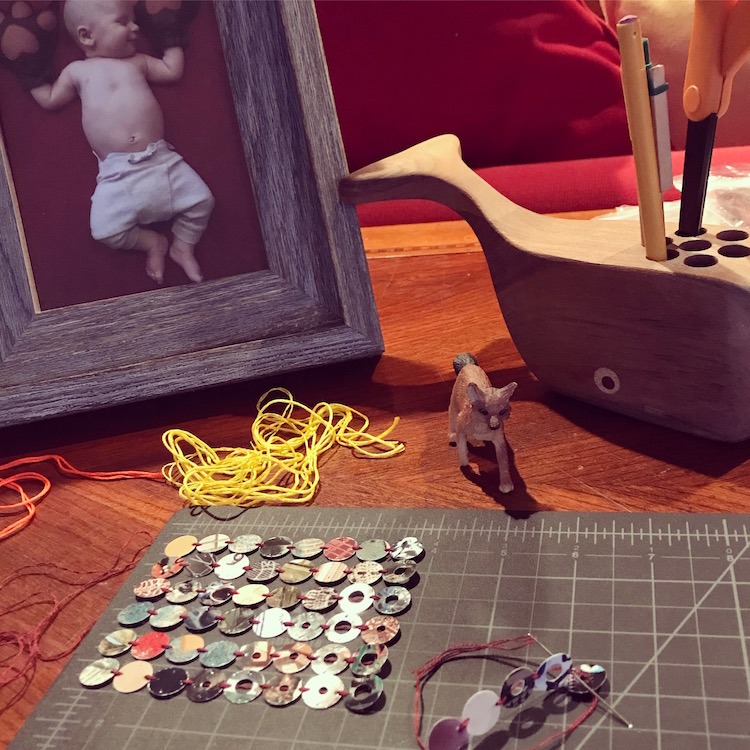
What currently inspires you?
My son, and it’s a twofold. Seeing a little human learn everything for the first time is so incredibly inspiring.
As adults we get jaded and take so much around us for granted. But kids get excited about every sound, taste, bus driving by, dog barking, and bubbles…oh the joy of bubbles.
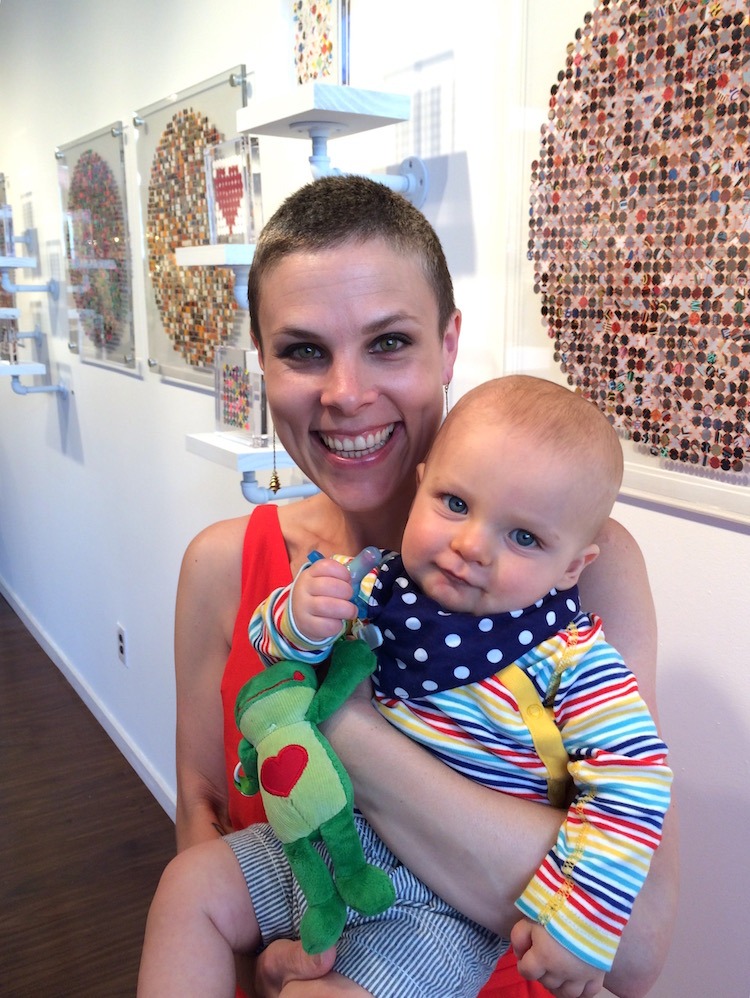
Seeing him have all of these new experiences has been extremely invigorating to my practice and made me a lot more mindful of my surroundings, which in turn inspires new ideas.
The other side is that having a toddler is extremely exhausting!
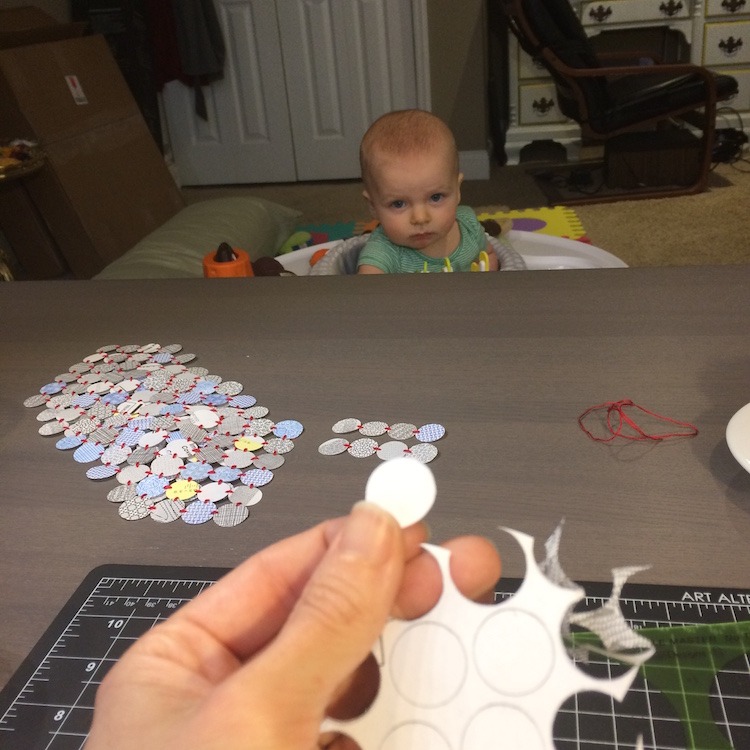
My work has always been very therapeutic to me, as I’ve struggled with depression and anxiety throughout my whole life. Sitting down and making art at the end of the day, grounds me and gives me time to breathe, process, and breakdown the day.
So I would say being inspired and making art definitely makes me a better mother and a more chill human overall.
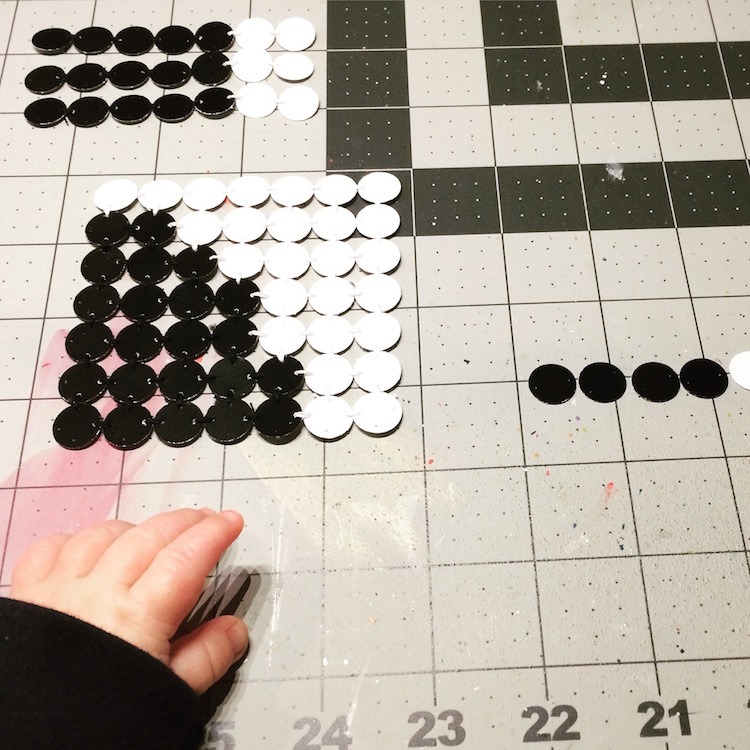
Security Blanket
Tell us about a piece of your work that holds particularly fond memories and why?
Without a doubt, it’s my piece titled Security Blanket. I actually wrote a whole zine about the piece, which is available through Paradigm Gallery + Studio, but I will give you a very abridged version.
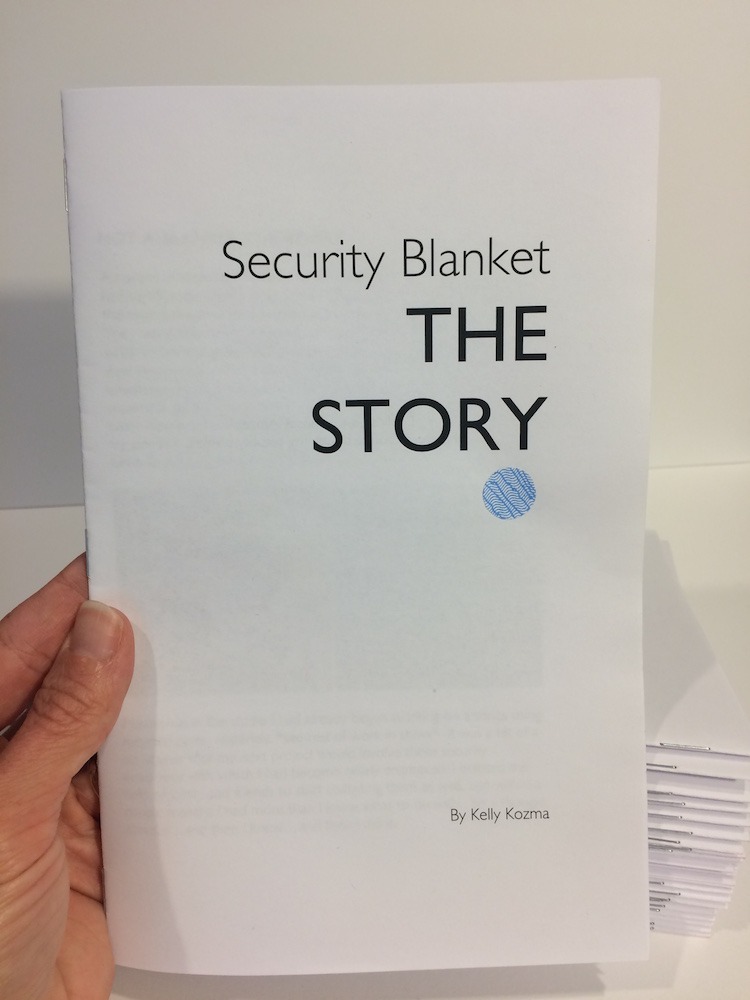
The piece is compiled of over 8,000 circles, hand-cut from security envelopes and hand-stitched together. It’s 60″h x 50″w.
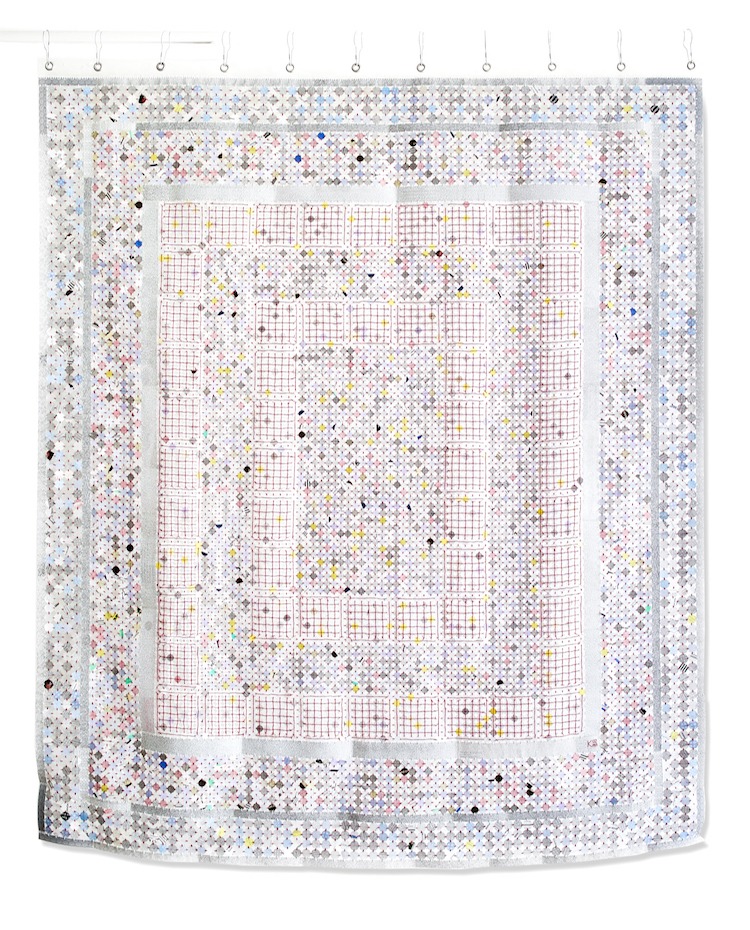
When I first began collecting the envelopes it was about aesthetics and giving these materials a second life in my art. But as the project grew, so did political tension, defeat, anger and hopelessness.
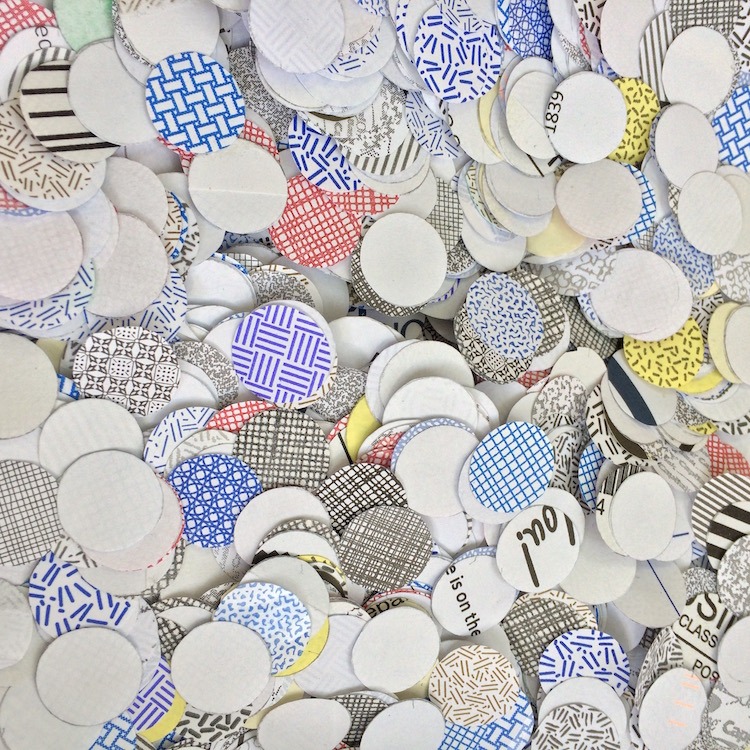
After November 8th, 2016 I realized that this piece wasn’t just about materials and process anymore. I wanted to create something that would make people feel good and give them emotional comfort, much like that of an actual security blanket.
That is why the large scale was so important to me. I wanted the size to reflect ALL the feelings. My anxiety of being a new mother; my confusion and anger about what was, and still is, happening in our country; not knowing what lay ahead of all of us.
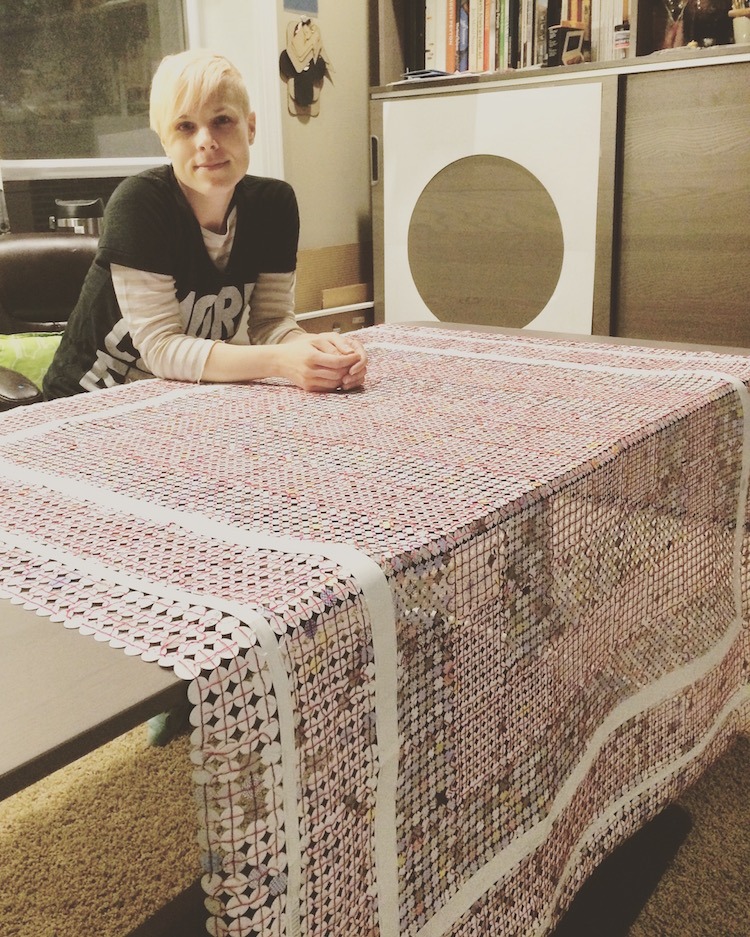
I also wanted to remind everyone that it’s ok to need a security blanket and in fact we should all have one or many.
The piece took on the greater theme of community and being able to come together, even when we don’t agree, to figure out how to make things work.
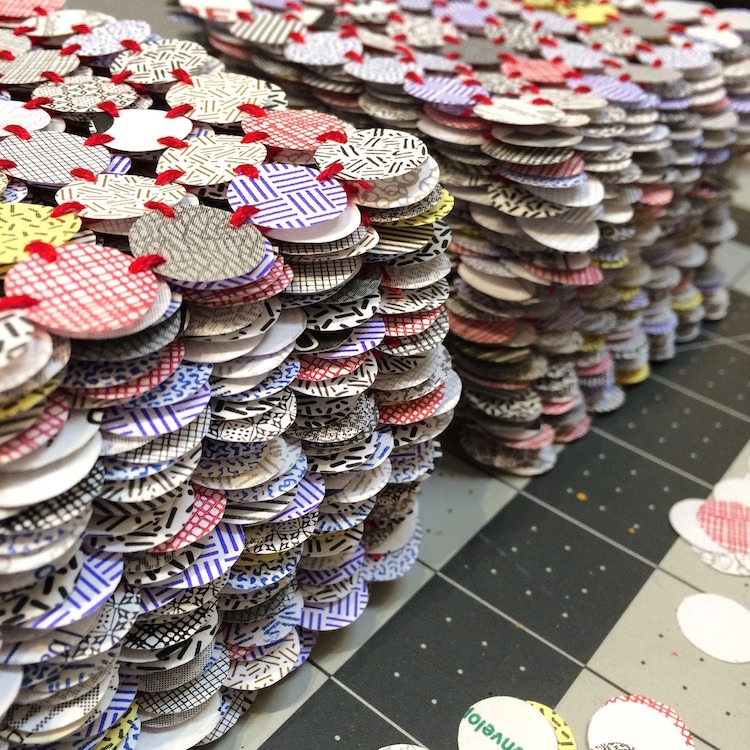
Security Blanket was first exhibited at my solo show POINT 5 at Paradigm, and more recently at Art on Paper 2018 in New York.
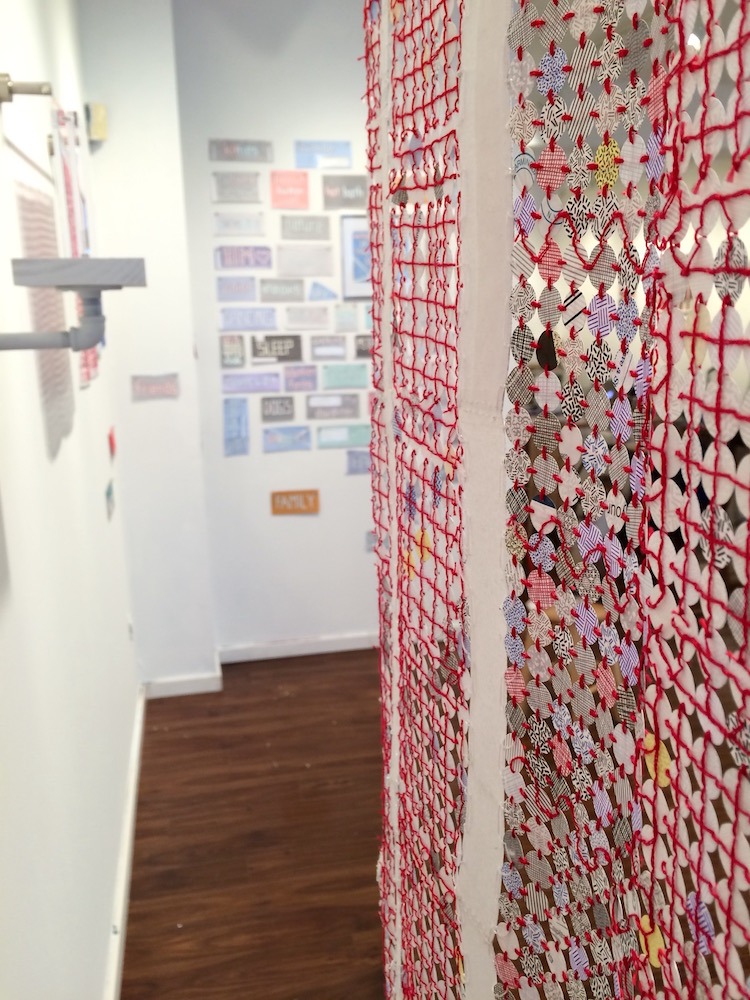
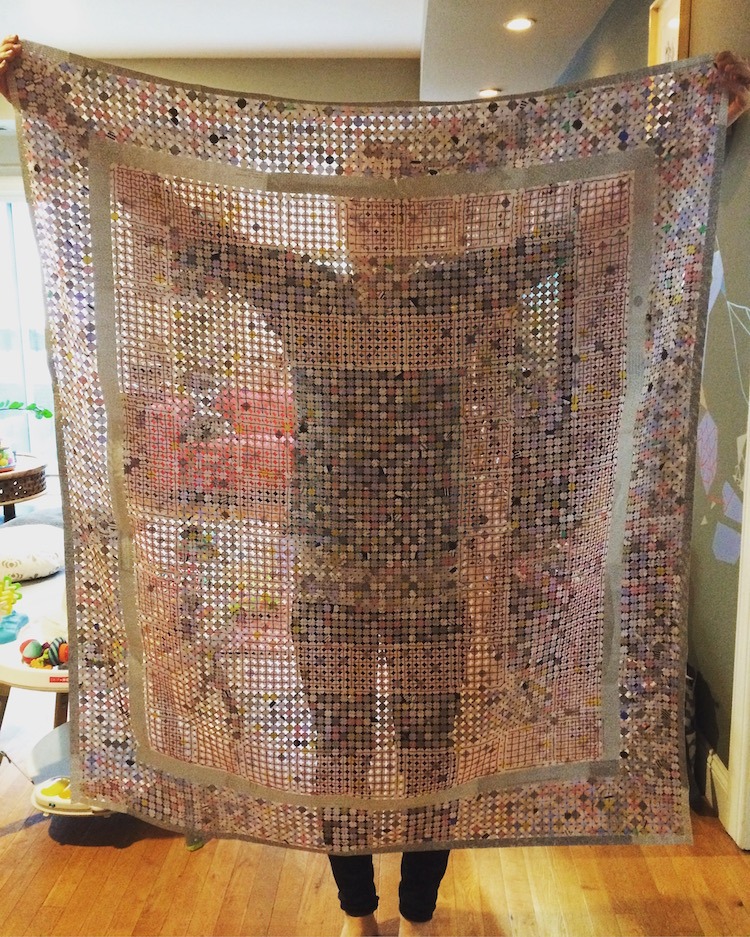
Exploring sculptural avenues
How has your work developed since you began and how do you see it evolving in the future?
Although my materials and process have changed drastically over the years, I would say the most important development in my work has been tightening and honing my craft.
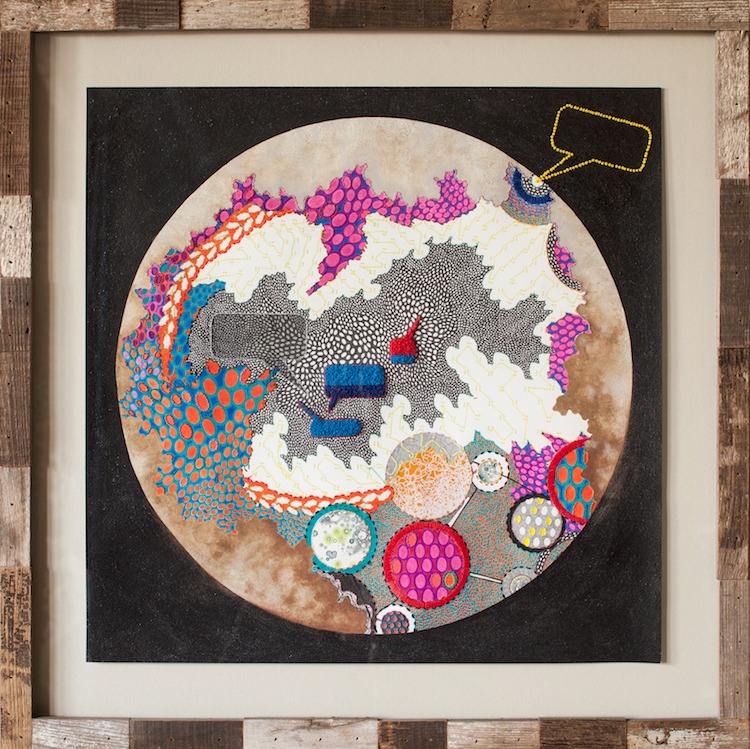
I’ve become extremely intentional with my decision-making and am pretty meticulous in my process, right down to each individual stitch or knot. I’ve also become much more aware of what I’m trying to convey through my work and the most successful ways of presenting that to the viewer.
I want to keep working with repurposed materials and pushing the boundaries of my punched paper pieces. I’d like to explore more sculptural avenues within the realm of textiles.
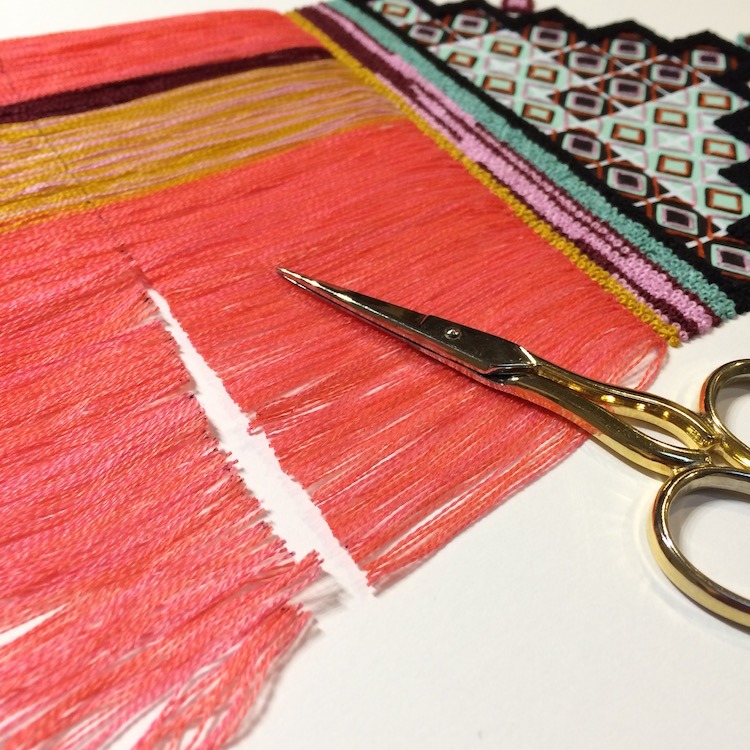
I’ve actually considered creating wearable art as well, which is funny because I had those stigmas when I was younger about textiles only being functional, and now it’s kind of come full circle.
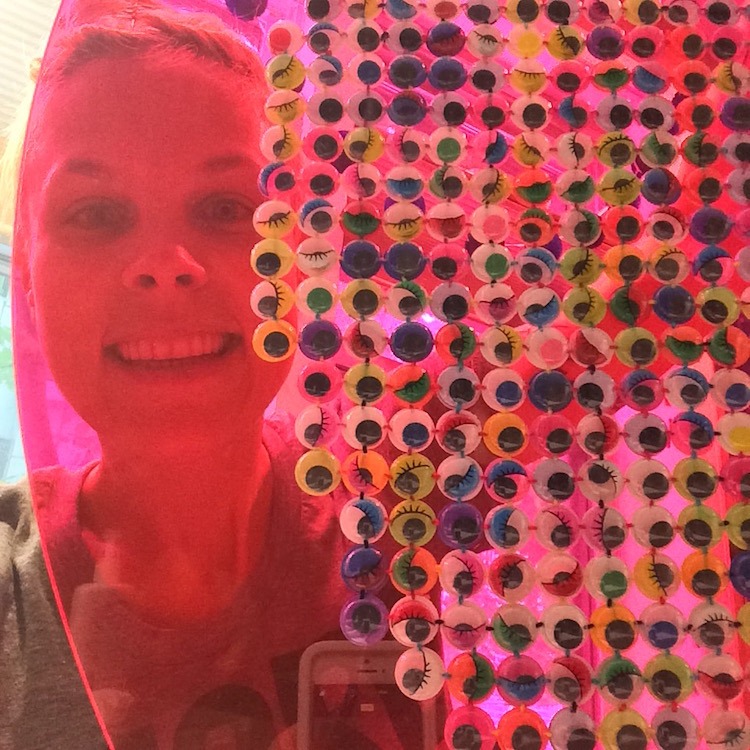
What advice would you give to an aspiring textile artist?
Look at all types of art, not just the likes of what you are making. Look at paintings, sculpture, digital art, photography, fashion, food, plants, cities…look all around you and then draw from those experiences.
Most of my inspiration comes from things that happen when I’m outside of my studio. And follow your gut, not what’s hot on Instagram. You will find your audience as long as you believe in the work you’re making.
What piece of equipment or tool could you not live without?
My needle and awl. I use the awl to hand-punch all of the holes in my paper before I start stitching. And although needles come and go, I get attached to them and it’s kind of sad when they break.
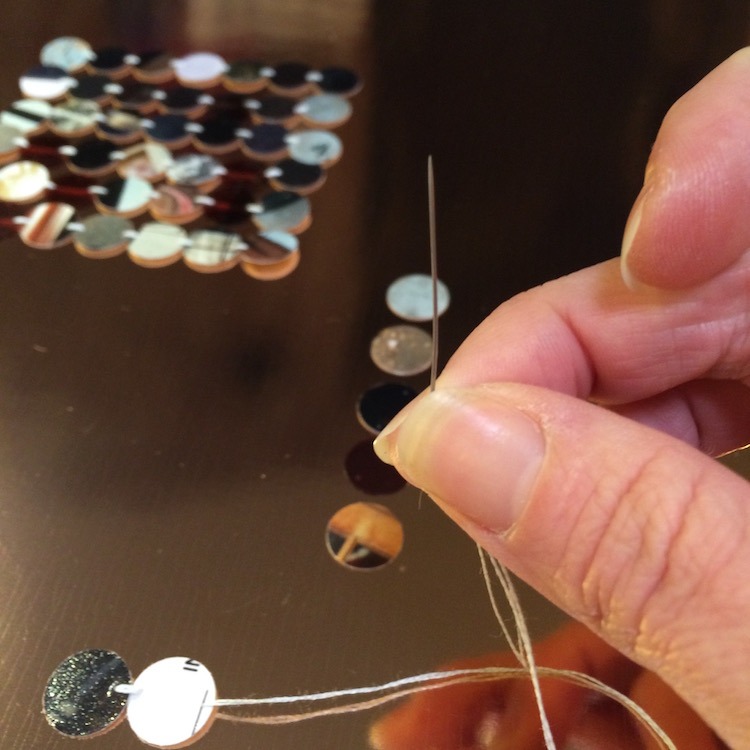
I actually made a piece featuring the needle that I used to make the entire body of work for one of my solo shows, including the piece Security Blanket. I don’t know how that thing didn’t break!
I stitched the words “This little thing helped to make a really big thing” below the needle.
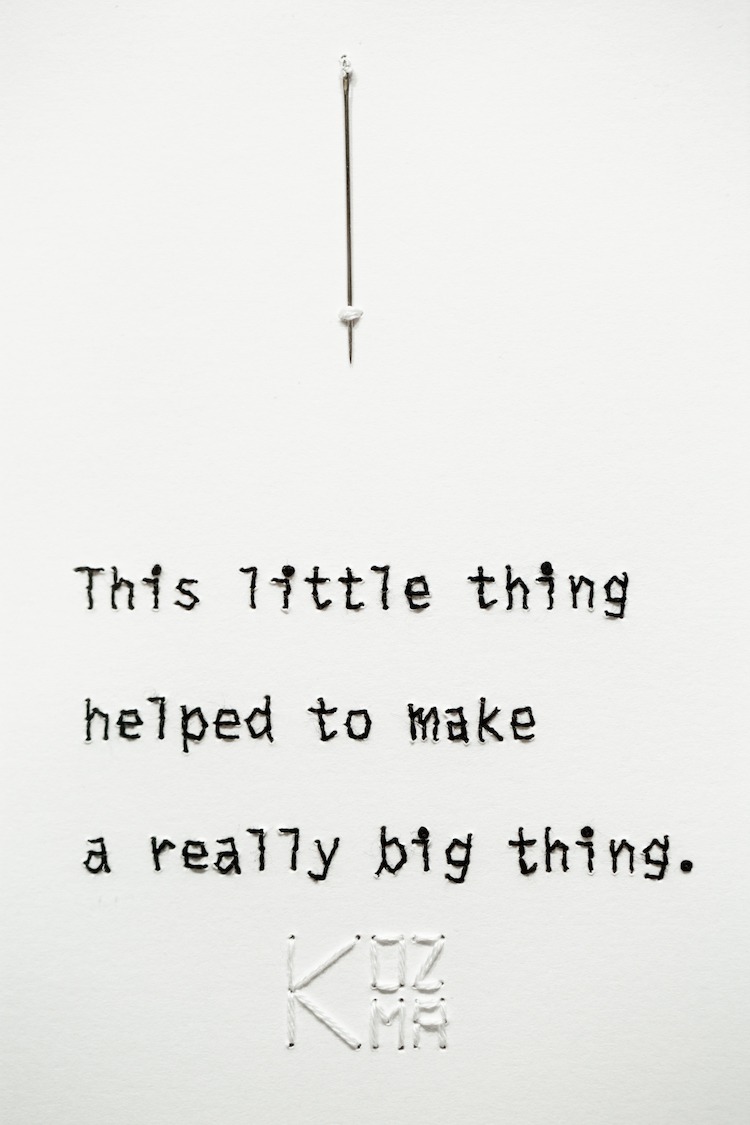
It’s still a very meaningful piece to me, and I’m so happy it found a forever home.
How do you go about choosing where to show your work?
Most of my solo shows have been with Paradigm Gallery + Studio in Philadelphia, who represents me.
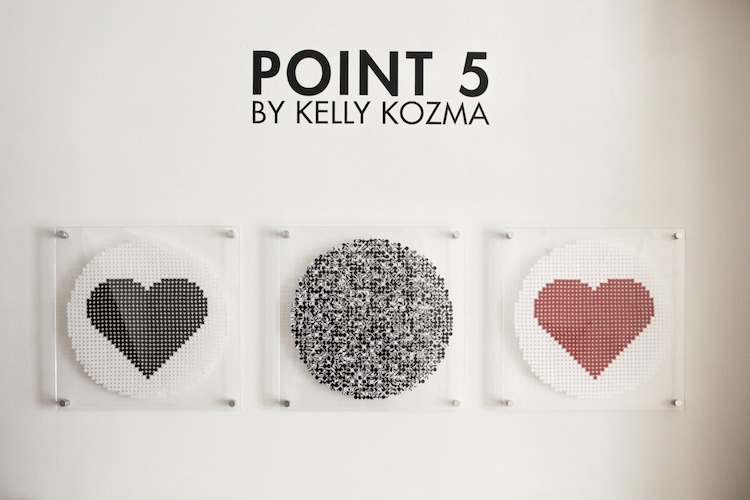
I’ve also had the privilege of showing at several art fairs with Paradigm including Art Basel in Miami and Art on Paper in New York.
I used to apply for group and solo shows a lot more, but as I’ve grown as an artist, I’ve become more selective about where I want to be, and therefore only apply for opportunities that really get me jazzed.
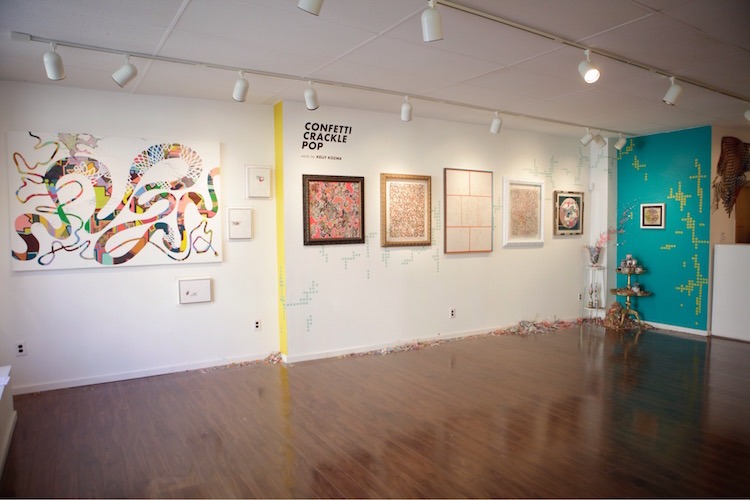
Where can readers see your work this year?
I’ve consistently had a solo show every year for the past four years, so I’m taking 2018 off to make new work, move into my new house, and plant some roots with my family, and of course to be inspired by all of these exciting changes as well.
In the meantime, you can see my available body of work at www.paradigmarts.org. And as an alternative venue to a gallery, you can check into Hotel Revival in Baltimore to see my work.
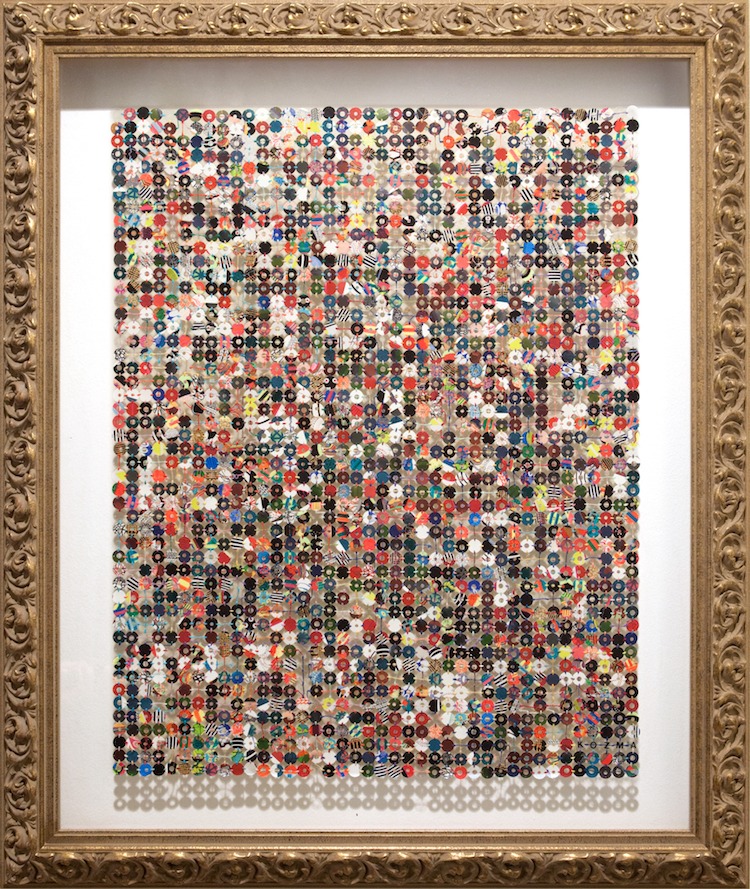
Paradigm recently curated all of the rooms in the hotel, featuring the work of 30+ artists, creating a dream getaway for any art lover. I’m so excited to have five pieces hanging in the presidential suite!
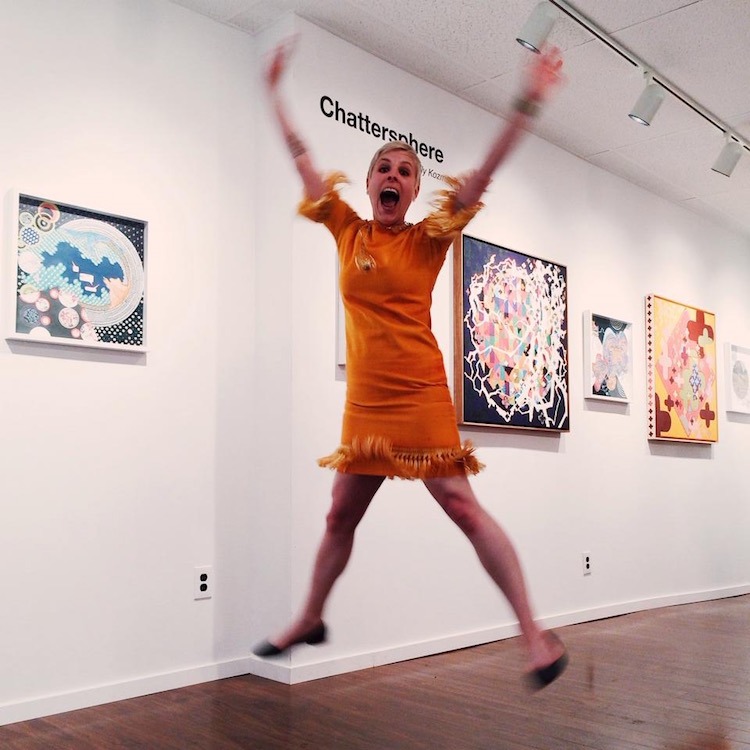
For more information visit: www.kellykozma.com or find Kelly on Instagram.
If you’ve enjoyed this interview why not share it with your friends on Facebook using the button below?
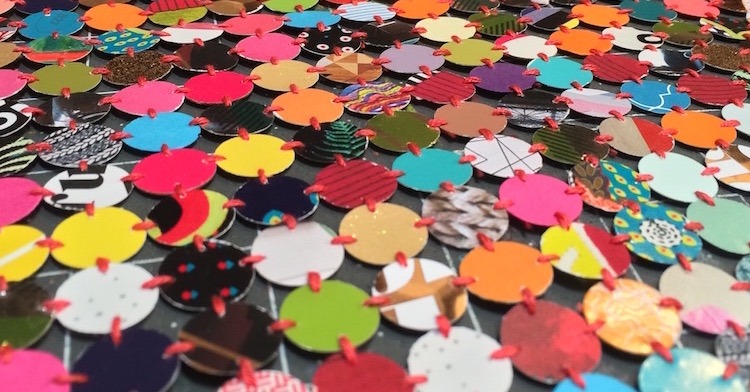

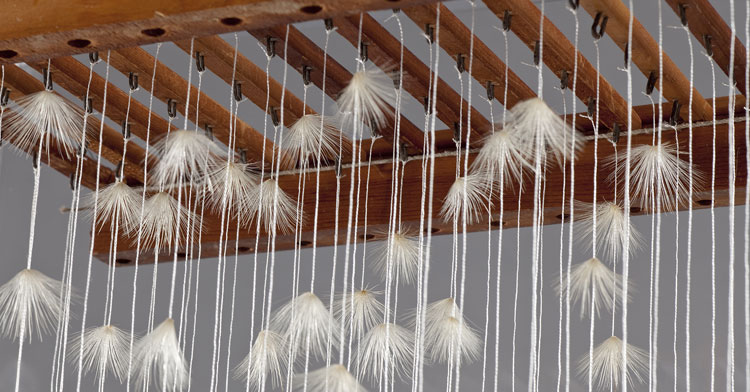
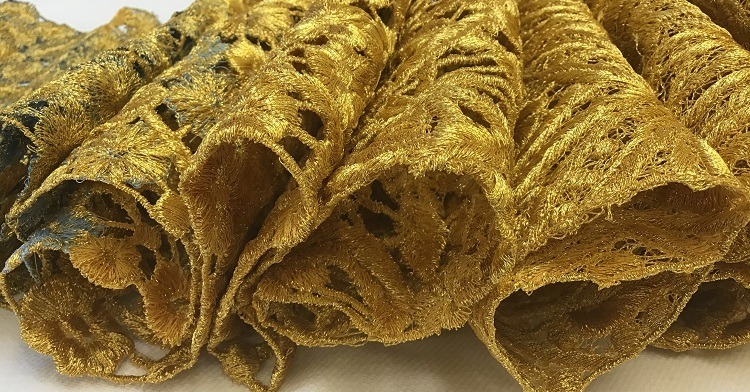
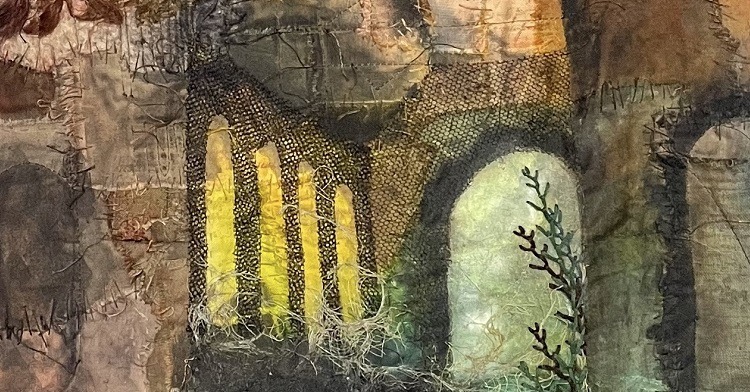
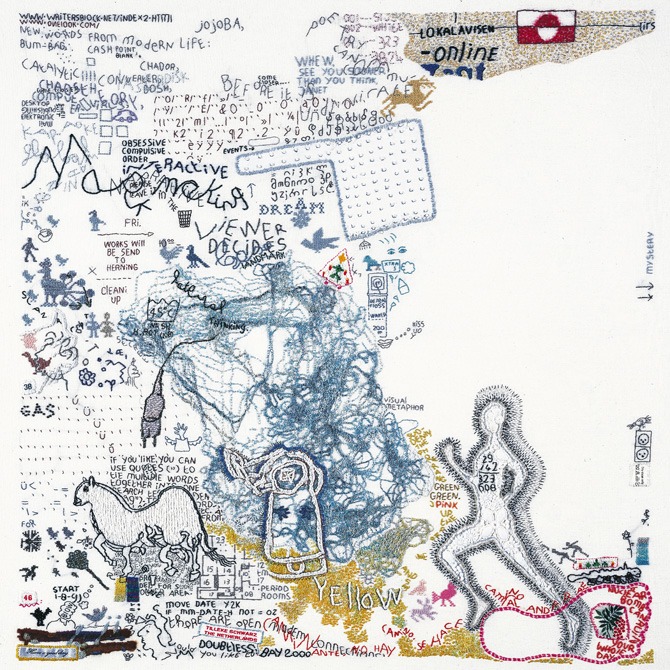
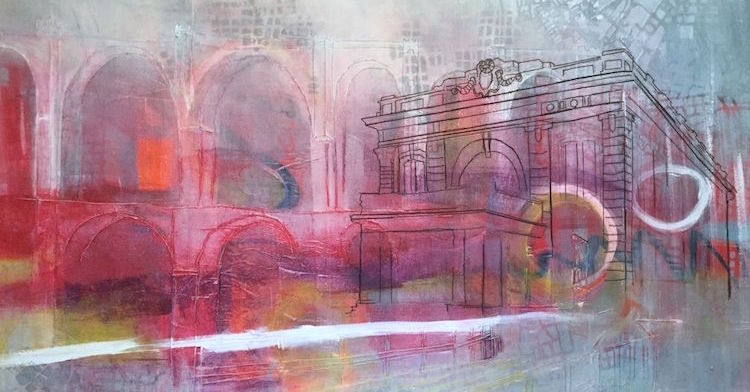
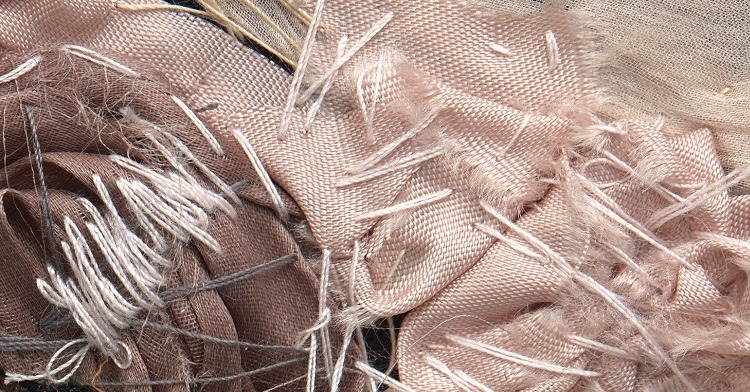
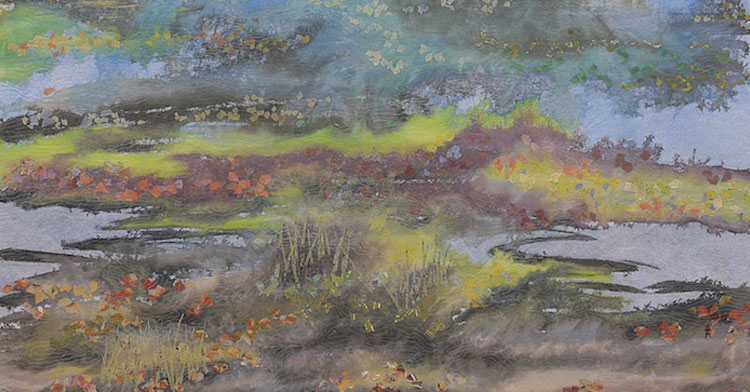
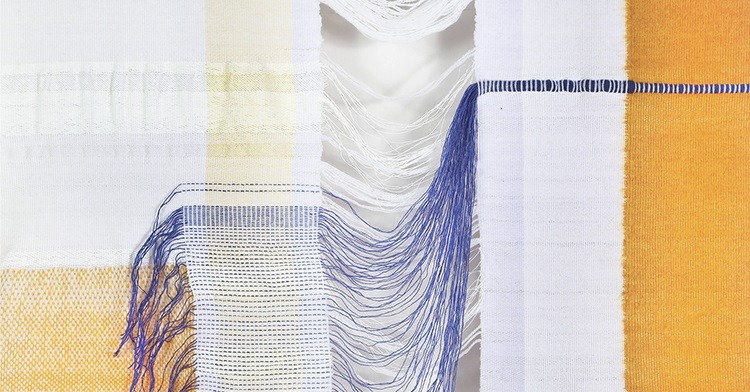
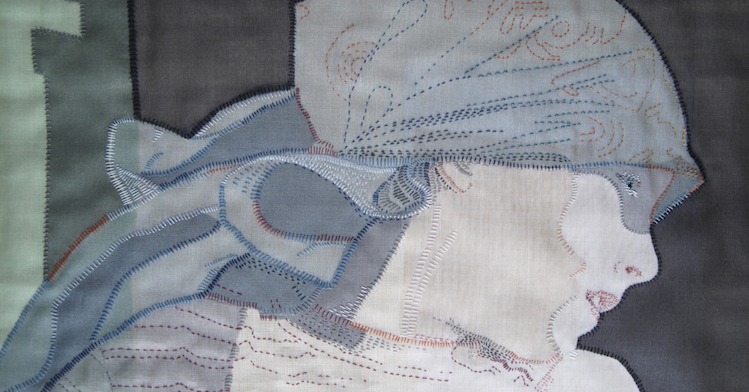
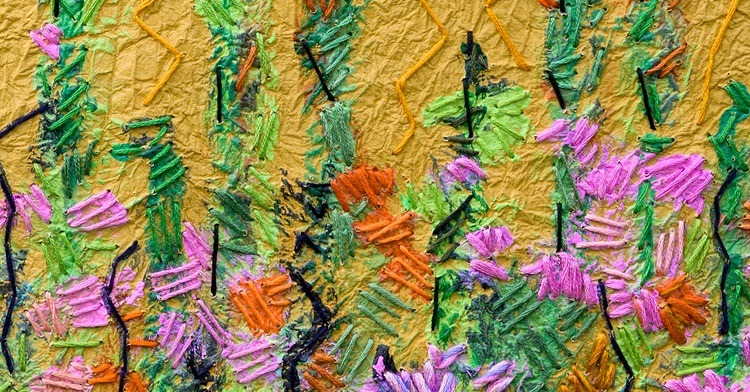
4 comments
Denise Abbott
Inspiring, such new and fresh ideas. Creativity is so centering; one of the few times I’m just in this moment. Love how you’ve taken everyday objects, security envelopes, and transformed them into something so beautiful. Just keepdoing what you’re doing, it’sfabulous.
Mary Mathews
Hi Kelly, Your work is continuing to evolve. I love and continue to teach the importance of the messages you incorporate into your work. Thanks for sharing this amazing interview. God bless you and continue to move you forward in life with that handsome son inspiring your journey.
Victoria Potrovitza
Hi Kelly, you are a breath a fresh air ! I savored every word of your interview. Your art is so unique, current, and most of all it SPEAKS TO ME. Being from California I can relate so much about your message. I was once a young mother and I admire your focus! It must be very hard to find time and space to create art. Each phase of your creative journey shows such artistic maturity. Love everything about you and your ART!
Katie Duff
Wonderful work, so fun and inspiring! I love the colours, the techniques, and the thoughts behind the works themselves. Thanks for sharing.